
‘Age-Friendly’ Care Takes a Continuum
Primary care practitioners find their role in systemwide efforts to care for those 65 and older.
repertoiremag.com vol.32 no.3 • March 2024








Made in the USA, OSOM Rapid Tests are highly accurate and dependable which helps you meet your customer’s point-of-care diagnostic needs. Simple procedure, fast results and high value features like QC Inside® Contact us at 800-332-1042 or visit us at osomtests.com Speed, Accuracy and Value. Awesome........yes, OSOM. Meet our awesome family © 2023 SEKISUI Diagnostics, LLC. All rights reserved. OSOM® and QC Inside® are registered trademark of SEKISUI Diagnostics, LLC. Because every result matters is a trademark of SEKISUI Diagnostics, LLC. QC Inside® feature is not available on all products.
Sniff
Streppy
Spike Beverly
Smoooch
Henry P. Lori Ruvee
BACTERIAL VAGINOSIS • COVID-19 • FLU A&B • HCG • H. PYLORI • IFOB • MONO • RSV • STREP A • TRICHOMONAS
Trixie

LEADERSHIP
36 Who Do You Want to Be in this Ever-Changing Environment?
It’s a question Cardinal Health’s
Jill Amicone asks herself as a leader and her team as it works to help health system providers strategize and prepare for the future.
10
11
14
22
and RSV are affecting the U.S. healthcare system.
TRENDS
30 How Do Your Physician Customers Get Paid?
Here’s what you should know about how your physicians approach employment contracts
38 Great Opportunities for Growth
As the aging population continues to grow and consumer preference moves away from institutional care, Cardinal Health’s Ryan O’Connor leads his team into new markets.
40 Words to Live By
Julee Prefer believes putting the needs of others first allows us to align our efforts to the success of all.
COMMERCIAL HEALTHCARE PROVIDERS
42 Privia Health drives growth through its five core services, recently signs on to more tech-based partnerships
The commercially traded healthcare provider has expanded its footprint to over 1,000 practice locations in the U.S.
44 CHPs in the News
TRENDS
45 CMS Behavioral Health Program
CMS announces new model to address the national behavioral care gap
Martha Bergstedt, Vice President
Roz Holloway, General Manager of
Optimization & Innovation,
The digital health landscape provides opportunities for organizations to make their mark.
Repertoire www.repertoiremag.com March 2024 1 MARCH 2024 • VOLUME 32 • ISSUE 3 Repertoire magazine (ISSN 1520-7587) is published monthly by Share Moving Media, 350 Town Center Ave, Ste 201, Suwanee, GA 30024-6914. Copyright 2024 by Share Moving Media. All rights reserved. Subscriptions: $49.00 per year for individuals; issues are sent free of charge to dealer representatives. If you would like to subscribe or notify us of address changes, please contact us at the above numbers or address. POSTMASTER: Send address changes to Repertoire, 350 Town Center Ave, Ste 201, Suwanee, GA 30024-6914. Please note: The acceptance of advertising or products mentioned by contributing authors does not constitute endorsement by the publisher. Publisher cannot accept responsibility for the correctness of an opinion expressed by contributing authors. Periodicals Postage Paid at Lawrenceville, GA and at additional mailing offices. Subscribe/renew @ www.repertoiremag.com : click subscribe CONTENTS ‘Age-Friendly’ Care Takes a Continuum Primary care practitioners find their role in systemwide efforts to care for those 65 and older. p. 24 PUBLISHER’S LETTER 2 180 Degrees PHYSICIAN OFFICE LAB 4 Just the Fats, Man! The importance of lipid tests in today’s physician office lab. TRENDS
Next Gen Sales Leaders Meet the future of med/surg sales.
The Sky’s the Limit Henry Schein’s Lauren Gerlants loves the thrill and the hustle of her field sales role.
Staying Power Cardinal Health’s Nate Spates Jr. on the importance of fostering customer trust, life-work balance, and more.
SALES EXCELLENCE
Security Alarms are Sounding!
you can become a financial closer.
18
How
INFECTION PREVENTION
No Time for Complacency Updates on how cases of COVID, flu,
IDN INSIGHTS 46 Supply Chain Leader Spotlight
Strategic
48 Supply
Leader Spotlight
Sourcing, Novant Health
Chain
Resource
LLC (ROi) 50 IDN News HIDA 52 Emerging Leaders Program Recognizes New Generation Of Supply Chain Professionals MARKETING MINUTE 53 Go-to-Market Strategies
HEALTH NEWS 54 U.S. Cancer Statistics Released Cancer rates are on the rise
younger adults. HEALTHCARE FACTS AND FIGURES 55 By the Numbers: Colorectal Cancer NEWS 56 Industry News
in
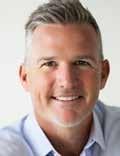
180 Degrees
Well, here we are in March – the “Madness” month, at least for college basketball. Speaking of madness, I have a crazy challenge for you this month. Whether you’re a distribution sales rep or a manufacturer sales rep, I want you to flip your view 180 degrees.
As you know, I mention one of my heroes, Scott Fanning, in my Publisher’s Letters a lot. There is a reason for that. He has given me so many pearls of wisdom that they often drive what I write about in this column. Scott always challenged those around him to look at issues from 180 degrees. This allows people the ability to face an issue from more than one angle.
As I travel the country talking with sales reps from both manufacturers and distributors, something that always comes up is their frustration that their counterparts never call them back. Often I will hear: “I give them a lead, then nothing happens, and no one returns e-mails.” What is interesting is both manufacturer and distribution reps say it about each other consistently.
I am often asked to speak at manufacturers’ sales meetings about the value of distribution, which has been near and dear to my heart for 28 years. I believe the heart and soul of our industry rests on the shoulders of the 5,500 distribution reps calling on the end-users. When I give this talk, I show a slide describing your average day:
Over 300,00 SKUs in your bag
150 plus emails a day
Over 100 texts a day
Back orders
New orders
Broken equipment
Multiple promotions going on at once
New office set-ups
25 plus voicemails
I tell the manufacturers this not to feel sorry for distribution reps, but so they have an understanding of how overwhelmingly busy you are. Now flip that 180 degrees and think about the manufacturer rep’s day.
Anywhere from 50-100 distribution reps and managers calling them
Follow-ups on end-user visits
Quotes
LVCs
Over 100 emails a day
Checking on orders
Checking on back orders
Sending samples
25 voice mails
Over 100 texts
So, my challenge to both parties this month is to step back and take a 180-degree view of your counterparts across the aisle, give them a break –and give them a call back. Challenge yourself to work on the relationship with 5 new manufacturers or distributor reps in the next months. Relationships make our world go round and will pay huge dividends. Also, challenge yourself to get back to people in 24 hours. I will do the same.
Dedicated to the Industry, R. Scott Adams
Repertoire www.repertoiremag.com
editorial staff
editor
Mark Thill mthill@sharemovingmedia.com
managing editor
Graham Garrison ggarrison@sharemovingmedia.com
editor-in-chief, Dail-eNews
Jenna Hughes jhughes@sharemovingmedia.com
art director
Brent Cashman bcashman@sharemovingmedia.com
circulation
Laura Gantert lgantert@sharemovingmedia.com
senior sales executive
Amy Cochran (West Coast) acochran@sharemovingmedia.com (800) 536.5312 x5279
sales executive
Aili Casey (East Coast) acasey@sharemovingmedia.com (404) 625-9156
publisher
Scott Adams sadams@sharemovingmedia.com
(800) 536.5312 x5256
founder
Brian Taylor btaylor@sharemovingmedia.com
Subscriptions
www.repertoiremag.com/subscribe or (800) 536-5312 x5259
Repertoire is published monthly by Share Moving Media 350 Town Center Ave, Ste 201 Suwanee, GA 30024-6914
Phone: (800) 536-5312, FAX: (770) 709-5432; e-mail: info@sharemovingmedia.com; www.sharemovingmedia.com
2 March 2024 Publisher’s Letter
Savanna®
HSV 1+2/VZV Assay
The power of certainty
Lesions for HSV-1, HSV-2, and VZV are misdiagnosed by visual examination in up to 20% of cases.
Make an impact for your patients with Savanna HSV 1+2/VZV Assay, a unique rt-PCR assay, by providing results up to 230% faster than a typical send out.*

The Savanna HSV 1+2/VZV Assay leverages real-time PCR technology with a differentiated VZV target to provide superior patient outcomes faster
For more information visit quidelortho.com

* Data on file. Copyright © 2024 QuidelOrtho Corporation. All rights reserved.
Just the Fats, Man!
The importance of lipid tests in today’s physician office lab.
 Advancements in the diagnosis and treatment of diseases often associated with advanced laboratory assays have come with such incredible speed that we sometimes forget the basic tests, the ones that underpin everyday diagnosis and treatment of patients to diagnose and treat the 10 leading causes of morbidity and mortality.
Lipid tests – total cholesterol, HDL, LDL cholesterol and triglycerides – often fall into this category. As a reminder, elevated lipid levels are directly associated with 3 of the 10 leading causes of death: heart disease, stroke and
kidney disease. In addition, in combination with other factors, they are also associated with diabetes. In total, they account for diseases associated with 40% of ALL the leading causes of morbidity and mortality in the United States today.
Is it any wonder that diagnosis and treatment of patients with elevated lipids is a major focus for primary care health practices across the U.S.?
Suppose for a minute that we could be more effective in diagnosis and subsequent
Repertoire www.repertoiremag.com 4 March 2024 Physician Office Lab
management of patients with lipid disorders. That advancement would have a profound impact on both life expectancy and quality of life. How would it impact your customers? In this column, I am going to review the basics surrounding lipid disorders as well as the most common lab tests that can quickly and effectively diagnose and monitor lipid disorders. As I have mentioned previously, “the primary reason to perform a test at the point of care is whether it can be used to initiate or modify a patient treatment program.” There is no doubt in my mind that lipid disorders fall directly into this category of healthcare concerns. Let’s review some facts together to understand the importance of lipid testing and patient management of lipid disorders.
Cholesterol and triglycerides are produced by the body and are critical to health (and disease)
As part of our understanding of the dynamics of lipid metabolism, we sometimes miss the obvious: cholesterol is produced by the liver and is the key building block of “steroid hormones” such as estrogen, cortisol and testosterone. HDL cholesterol is also naturally occurring and acts as a transfer protein to scavenge cholesterol from the bloodstream and return it to the liver to be removed from the body. LDL is also synthesized by the liver. Triglycerides are produced by the liver and occur in many of the foods we eat. They are used to store calories for later use. It goes without saying that these lipids are essential
to life, but that the difference between health and lipid disorders results from the amount of these lipids in our body.
There are “know your numbers” campaigns regarding blood pressure, glucose and lipids conducted routinely across the country. Some are conducted locally and others in association with health advocacy groups. You would be well advised to find these programs locally and offer your support.
The generally accepted “numbers” for lipids follow:
Cholesterol (lower is better)
Desirable: less than 200 mg/dl
Borderline: 201-240
High: 240 or greater
HDL cholesterol (higher is better) 60 mg/dl or higher is desirable 41-59 mg/dl is “ok”
Below 40 is undesirable
LDL cholesterol: lower is better Less than 100 is desirable
100-129 is slightly elevated
130-159 is borderline high 160-189 is high
Greater than 190 is very high
Triglycerides: lower is better 150 mg/dl or lower is desirable (physicians tailor the level to lower values for at risk patients)
151-200 mg/dl is moderate risk
Greater than 200 mg/dl is high risk
Individual patient age and risk factors are also taken into account when physicians tailor specific lipid goals to each patient, which is another reason for testing at the point of care where the entire patient presentation can go into a comprehensive treatment program including lipid management, vital signs measurements and lifestyle modifications.
How well established is the evidence of linkage of elevated lipids associated with cardiac risk?
If any data on overall heart disease risk factors can be considered “bulletproof,” there is no question that all the needed evidence for lipid management has been compiled, continues to be published and analyzed, and that recommendations for lifestyle modification (blood pressure control, healthy diet, exercise and cessation of smoking) have been published by multiple clinical authorities. The pivotal first study, the Framingham Study, began in 1948 and established the risk factor criteria for heart disease for the first time in a single comprehensive study. It initially enrolled over 5,000 men in their middle years. In 1971, a second generation of over 5,000 study participants was enrolled, and incredibly in 2002, a third generation of participants was enrolled. Arguably, the Framingham Study
Remarkably, while blood pressure testing is an established element of vital signs measurements in every patient visit, lipid testing, particularly in younger patients, often is not.
Repertoire www.repertoiremag.com March 2024 5
is one of the longest lasting longitudinal studies of heart disease from all causative factors.
The list of subsequent studies confirming the validity of the Framingham study is too exhaustive to list, but the Multiple Risk Factor Intervention Trial (MR-FIT ) which ran from 1972 through 1998 and enrolled over 12,000 participants is another well-known and often cited reference in this area. This study focused on reduction in saturated fats in diet, reduction in cigarette smoking and control of blood pressure. The study concluded that the “special intervention” group that sought to control these risk factors compared to the control group that did not have significant reductions in heart disease and heart attack. These findings, and the recommendations of an array of well-established clinical authorities including the National Institutes of Health, American Heart Association, and the US Preventive Services Task Force have clearly supported and published these findings in both peer reviewed and general publications. Your clinician customers have been extensively trained to counsel their patients on lifestyle improvements and to routinely check both blood pressure and lipid levels. Remarkably, while blood pressure testing is an established element of vital signs measurements in every patient visit, lipid testing, particularly in younger patients, often is not. Moreover, even testing for the at-risk population (smokers, obese patients, those with elevated blood pressure) are often subject to send out testing rather than testing at the point of care. As a result, key opportunities
for patient counseling and immediate intervention are often missed. As consultants, a portion of our job is to reinforce the many reasons to test at the point of care and create an environment where patient counseling and immediate prescription of lipid lowering medications can result in optimal patient results.
What about lipid testing?
The US Preventive Services Task Force (USPTF) is well regarded by physicians for practical, data supported recommendations across multiple patient conditions and tests. Their most recent lipid screening recommendations were first published in 2008. These
Every year, millions of Americans with lipid disorders, diagnosed or otherwise, visit their primary care practice. Based on the prevention and treatment guidelines presented above, many of these patients would benefit from immediate lipid screening along with routine vital signs monitoring. Your customers should be providing these key services.
The facts on management of lipids Statins were the first lipid management medications proven to lower total cholesterol levels. They were first introduced in 1987 and their use has been rising dramatically since then. Thirty-one million patients were on statins in 2008. Only 10 years later, in 2018, the number had risen to 92 million. It continues to increase annually. In 2002, the FDA approved the use of a different lipid lowering agent, ezetimibe, with a different mechanism of action. Statin lowers lipids by reducing production of lipids in the liver. Ezetimibe lowers lipids by inhibiting cholesterol absorption in the intestine. Physicians often use a “mix and match” approach to using both medications in combination.
screening recommendations are to screen asymptomatic men starting at age 35, and those with risk factors beginning at age 20. They recommend initiating screening for women at age 45 if they have no known risk factors and at age 20 if they do. Their recommendations are available at uspreventiveservicestaskforce.org.
Many primary care practices use this information and modify it based on known or suspected patient risk factors including family history, weight and body mass index, blood pressure and other factors. It is worth your time to ask your key customers how they use these recommendations and use that information as a bridge to deeper conversations about the value of testing at the point of care.
Repertoire www.repertoiremag.com 6 March 2024 Physician Office Lab



Smear with safety.
Stain with consistency.
Analyze with confidence.
High-quality peripheral blood smears are essential for accurate manual differential results. The DIFF-Line™ by CellaVision helps your lab produce exceptional slides, efficiently and easily. Closed-vial, automated smear prep and methanol-free, premixed stains provide the perfect slide for automated cell imaging. The best things come in threes.
Visit sysmex.com/Diffline

For 24 consecutive years Sysmex has rated highest for System Reliability.*
©2024 Sysmex America, Inc. *2023 IMV ServiceTrak™ Annual Survey for Hematology
RAL® SmearBox
RAL® StainBox
CellaVision DC-1
POC testing options
Because the linkage between lipid disorders and heart disease has been so well established for so long, a broad range of lipid testing solutions is available. There are multiple fast, accurate waived lipid testing solutions and your key lab suppliers will each offer their reasoning for why their option has distinct advantages. In addition, for larger labs with well-established, full-service laboratories, there are a multitude of automated chemistry testing solutions in the market. Their primary advantage is cost, but since lipid tests are often batched on systems of this type, results may not be available at the point
of care. These are trade-offs you need to be familiar with and prepared to discuss with your customers and prospects. From a result quality perspective, NIH National Cholesterol Education Program established performance metrics over three decades ago and methods on the market today meet or exceed these standards. Ask your key lab supplier for more information to be prepared for customer questions about result quality. Many customers still equate waived tests as “adequate” but not as good as moderate complexity tests for the same analyte. For lipid testing, there is no evidence this is true.
CPT codes
The Clinical Lab Fee Schedule (CLFS) of Medicare defines a lipid panel as cholesterol (total, HDL and LDL) and triglycerides with the CPT code 80061 with and without the QW (waived test) modifier. The reimbursement is national and the latest 2004 CLFS reimbursement was $13.00. Stand-alone direct LDL testing is covered by CPT code 83721 (with and without QW modifier) and reimburses $11.00. As a rule, Medicare payers discourage “unbundling” test panels. Be sure to stay informed by learning the rules in your area with home office and key manufacturer guidance. When in doubt, assume “unbundling” is a bad idea and should be discouraged.
Every year, millions of Americans with lipid disorders, diagnosed or otherwise, visit their primary care practice. Based on the prevention and treatment guidelines presented above, many of these patients would benefit from immediate lipid screening along with routine vital signs monitoring. Your customers should be providing these key services. If they are not, you owe it to yourself and these key customers to engage in discussions along with your key lab manufacturers to point out the clear and undeniable evidence that routine measurement of lipid tests at the point of care leads to better health outcomes.
Commit to this strategy with your key lab manufacturers and you will be making a difference for patient satisfaction and the overall health of your community. Your customers will thank you.
Repertoire www.repertoiremag.com 8 March 2024 Physician Office Lab
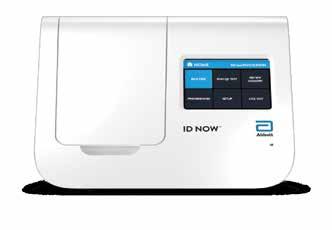


Next Gen Sales Leaders
Meet the future of med/surg sales.
Selling ain’t like it used to be. Just ask any seasoned vet or newly minted rep, and they’d tell you the same thing – the industry has changed. Customer expectations are different. And with it come the need for new ideas and a consultative approach to the way reps call on their accounts.
Repertoire interviewed several up-and-coming distributor and manufacturer reps about what this new landscape looks like. In the following series, these reps shared their roles and responsibilities, what they need from their organizations to succeed, recent marketplace changes following the pandemic, and more.
Repertoire www.repertoiremag.com 10 March 2024 Trends

The Sky’s the Limit
Henry Schein’s Lauren Gerlants loves the thrill and the hustle of her field sales role.
 Lauren Gerlants can point to her time as a dental hygienist to when she got her start in sales. Although a bit unconventional, the dental office she worked for wanted its hygienists to promote certain products like electric toothbrushes and whitening toothpaste with clients. Gerlants discovered two things in that job. First, she was really good at sales. And second, she enjoyed it much more than being a hygienist.
Eventually, she would quit her role as a dental hygienist to work for a dental distribution company. Then, a chance LinkedIn message from a Henry Schein Medical sales manager led to a conversation about medical sales, which
eventually snowballed into a field sales role with the company.
Henry Schein’s culture was “hands down” a key factor in Gerlants accepting her role with the company, she said. Before she started, she reached out to

Repertoire www.repertoiremag.com March 2024 11
Lauren Gerlants
Trends several Henry Schein reps via social media to see if it would be a positive work environment. She found that whoever she talked to her would rave about the culture and opportunities. “It made me very comfortable to step into an area that I was unfamiliar with,” she said. “I said, ‘Okay, at least the culture here is solid.’”
Gerlants knows that if she needs to speak to company leaders, they will take her call. “My voice is heard here,” she said. “If I have any issues with anything, my manager will always hear me out and send it up if need be. It’s just a very close-knit kind of feel. And it’s so important to know that my voice matters. I know there are so many reps. I get it. But every one of us counts the same, no matter what. That’s important.”
Accelerated learning
Gerlants started with Henry Schein in 2021 during the second year of the COVID pandemic. She knew very little about medical products, so the process of getting up to speed on antigen tests, PCR tests, and the thousands of other SKUs so she could speak knowledgeably in front of customers felt a little bit like drinking from a fire hose. “It propelled me to learn at an accelerated speed,” she said. “We didn’t have a choice. It was a sink-or-swim situation.”
Building relationships with clients meant being reactive to their needs. Most physician offices were coming to distributors for products and solutions. Gerlants learned very quickly that she didn’t only want to sell COVID. “I would use COVID, sell it to them, and then I would sneak in little things after that,
like gloves and ancillary products, as much as I could.”
Today’s marketplace is different. Gerlants said to succeed now means having a hunter’s mentality. Reps must be more proactive instead of reactive because their phones are not ringing off the hook. “People don’t necessarily need us for those tests anymore. So you’ve got to go out there now versus then.”
friends,” she said. “Because there are so many SKUs, you can’t possibly know everything about every product. But making friends within the organization, learning what’s working for them and then trying to bring it to my area has helped.”
She’s also a big proponent of podcasts while traveling or in-between calls. Popular business podcasters like
Physician offices are counting their dollars and cents. Earning revenue has become more challenging amid rising inflation and subsequently rising costs. The smart offices are leaning on their sales reps for help.
Physician offices are counting their dollars and cents. Earning revenue has become more challenging amid rising inflation and subsequently rising costs. The smart offices are leaning on their sales reps for help, Gerlants said. “Henry Schein is brilliant at offering solutions, truly. So I lean on those solutions a lot and try to integrate them into the business. Here’s how you make money depending on your practice, depending on your specialty. But it’s counting pennies right now, for sure. The economy has changed, and we have to roll with it.”
What drives you?
Gerlants has made it a point to talk to reps from other states to get a better feel for what’s going on in different physician office markets, and what products she should be talking about with clients. “I love making genuine connections, and genuine
Gary Vaynerchuk are helpful in improving her sales game. “Gary Vaynerchuk is one of my favorites because he speaks to the personal connections that you should make through business. After those connections, then the money comes. It’s not about the dollars and cents, it’s about a human connection.”
Short-term, Gerlants is fully invested in growing her territory. “The sky’s the limit,” she said. “Like everyone in sales, making money drives me. So, if I can grow it exponentially, I might die trying, but I’m going to do it.”
Long-term, Gerlants doesn’t want to give up the thrill of sales, but she is interested in pursuing something management related. Perhaps even a blend of both. “It’s such a toss-up because I love being in front of people, but I also love managing. Maybe there’s a hybrid position that could exist out there? I think longterm that would be amazing.”
Repertoire www.repertoiremag.com 12 March 2024
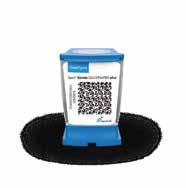

Staying Power
Cardinal Health’s Nate Spates Jr. on the importance of fostering customer trust, life-work balance, and more. By Jenna
Hughes

 Nate Spates Jr. had always been curious about a career in sales. His father-in-law suggested Spates’ demeanor and interpersonal skills would make him a great fit with a company within the medical sales sector.
Repertoire www.repertoiremag.com 14 March 2024 Trends



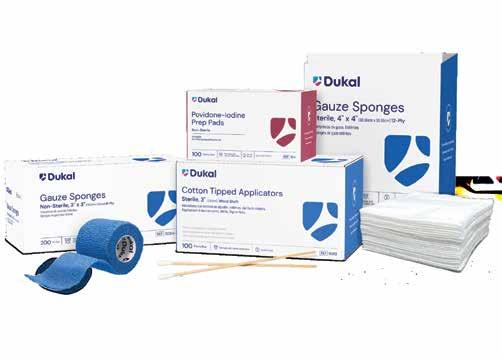
Turns out he was right. In the summer of 2021, Spates joined Cardinal Health as a Non-Acute Territory Sales Representative for Memphis and the surrounding area. As Spates has quickly learned during his time in the industry, listening is key to not only client relationships, but for all relationships. Being accessible for customers, especially in a demanding marketplace, not only assists with selling, but garners trust between customers and sales reps.
 Nate Spates Jr.
Nate Spates Jr.
On the topic of customer trust, Spates said “letting your customers share their feelings shows that they’re comfortable enough with you to tell you how they’re feeling. I see it as a badge of honor when a customer trusts me enough to tell me how they’re feeling – and they’re giving me the opportunity to help resolve the issue.”
Learning from experience
Spates began his role with Cardinal Health on the heels of the pandemic. Dealing with supply chain disruptions and material shortages taught him that it’s in a sales reps’ best interest to come prepared to customer meetings with suggestions for product alternatives.
Indeed, supply shortages are among the many obstacles that medical sales reps continue to face. Knowing how to overcome this, and researching and communicating with customers about their specific needs, can help sales reps meet their customers’ expectations.
For advice and guidance, Spates seeks advice from individuals who
Strong leaders that guide sales teams are important to the success of the organization and to help employees avoid unnecessary stress over unknown factors.
“Before you jump to problem solving and finding resolutions, it’s important to let customers share their concerns or vent frustrations,” Spates said. “This is one of the best opportunities to connect with them.”
Trust between sales reps and businesses is vital to success, as without trust, there is unlikely to be sales progress.
have worked in medical sales for over 20+ years, as they have seen an era or two come and go in the industry. He says, “I’m curious about their staying power, what their relationships with their customers are like, customers they won over time and customers they’ve lost. This gives me a good picture of the rep/client relationship, which I believe is the most integral part of this role.”
Life-work balance
The industry is rapidly changing, and physicians in the industry are apprehensive, with many wondering what the “next big thing” will be to change the world of healthcare.
“Physicians and physician offices can exhaust a lot of bandwidth spending time preparing for anything that might go wrong – time which they could be using towards growing their medical practices,” said Spates. “This is a challenge, since there is no real way to pinpoint the next big issue or where it could be coming from.”
Strong leaders that guide sales teams are important to the success of the organization and to help employees avoid unnecessary stress over unknown factors.
Support from leadership is critical for today’s field rep. Cardinal Health’s corporate structure allows for ample employee support and many upward mobility opportunities, Spates said. “It doesn’t matter what position someone is in the company – at Cardinal Health I feel comfortable reaching out to anyone,” he said. “Culture is very important to any company, and it must be genuine. I take the word ‘culture’ very seriously and I am proud to say that I work for a company that has a great culture.”
As for looking forward in terms of his career, Spates said he would like to be able to affect the most change for Cardinal Health while maintaining a lifework balance. “I deliberately put life before work and try not to put timelines on my career,” he said. “If I focus on being the best version of myself daily, the right doors will open at the right time, and I will be prepared to walk through them.”
Repertoire www.repertoiremag.com 16 March 2024 Trends
Comprehensive
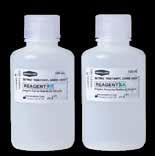
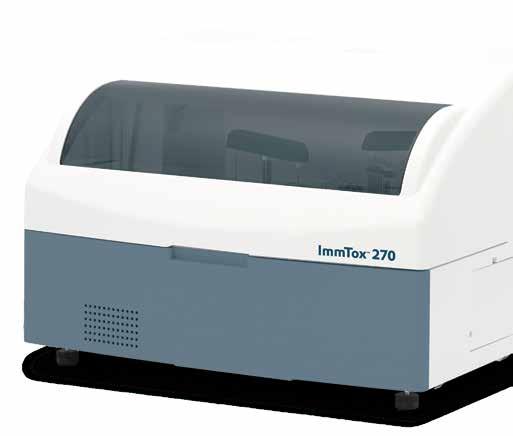
Toxicology screening solutions for physician offices, pain management, treatment centers and laboratories testing 200+ patient samples/mo.
assays. Scan this QR code

MODERATE COMPLEXITY ASSAYS – FDA 510(K) CLEARED
6-acetylmorphine (6-AM Heroin metabolite)
Amphetamine
Barbiturates
Benzodiazepines
Benzoylecgonine (Cocaine metabolite)
Buprenorphine
Cannabinoids (THC)
video
EDDP (Methadone metabolite)
Fentanyl*
Methamphetamine
Opiates
Oxycodone
Phencyclidine (PCP)
Tramadol
TOXICOLOGY SCREENING SIMPLIFIED.
™ 270 BENCHTOP ANALYZER © 2022 Abbott. All rights reserved. All trademarks referenced are trademarks of either the Abbott group of companies or their respective owners. Any photos displayed are for illustrative purposes only. COL-09575 v3 09/22 1. Clinical Laboratory Improvement Amendments (CLIA) / * SEFRIA Fentanyl
IMMTOX
complexity
toxicology menu now with 14 CLIA 1 categorized moderate
to view the ImmTox™ 270 product
CONTACT ABBOTT CLINICAL LAB SOLUTIONS 855-425-9428 | CLS_SALES@ABBOTT.COM
Security Alarms are Sounding!
How you can become a financial closer.
By Brian Sullivan
 Your prospect can love every feature and benefit of your product or company, but unless you convince them the cost justifies the benefits, you will not get a sale. Too many salespeople do a fantastic job of convincing their prospects of the benefits of their solution only to fall short during the financial discussion. If you sell products or services that cost tens of thousands of dollars, you may be presenting several different financing options. With these different options often comes different paperwork that needs to be authorized by the prospect. Never enter a sales call without all the necessary financial paperwork. This can destroy the flow of the call and prevent you from getting the order. Bring all of it with you.
It’s not only important to bring your order forms, leasing agreements, sign up sheets, or whatever you may call them, it is also crucial that you become intimately familiar with every word on those sheets. Know every detail (and where every bit of customer information needs to go just like you know every detail of your product itself). And if the goal is to convince the prospect of the value of one of your consumable or pharmaceutical products, you too need to be prepared to help them financially justify why they need it. Come prepared with an ROI calculator, and some existing client financial success stories or testimonials from happy customers.
Justify the sale
If a salesperson isn’t prepared to quickly answer the question, “How do I financially justify making this part of my practice?” then indecision will set in for both sales rep and prospect. This lack of pre-call preparation usually

Repertoire www.repertoiremag.com 18 March 2024 Sales Excellence
creates the sales rep response of, “Let me get you some pricing and I will get back to you.”
The sales rep that makes this sentence part of their everyday selling vocabulary might as well just say, “I am unprepared to close the sale today and pray to the Lord above that you will still be interested when I email over the quote and information.”
Unfortunately, clients go back to other priorities in their life and practice after we are done presenting, so we can’t rely on the fact that they will still be interested once we get them a “quote.” Be prepared to deliver it the same time you present the value of your product or service.
After you do a great job of helping them justify the cost, watch your prospect’s behavior and listen closely to how they respond. If they give you Positive Financial Security Alarms, it is time to ADVANCE the sale. Positive body language and security alarms should be enough of a green light for you to try to gain commitment. So don’t feel the need to ask if the finances make sense if the alarms already told you they do.
Advance the sale
To ADVANCE the sale out of the presentation phase and into the post-sale phase, try a “Detail/Two-Choice” Question. An example would be:
“Great John. I’m glad that you find the value of making this part of your practice. Then with your permission, I would like to get a date scheduled in my planner when it would be most convenient for us to train your team on how to use/ market my product. Would next week, or the following week work better for your people?”
Let’s break it down:
“With your permission...” These are very important words in helping you to keep the customer feeling pressure free. They must always feel as if they are in control, and these three words help you do this.
“…date scheduled…”
This is ADVANCING at its finest. It is an attempt to turn your presentation into a concrete order. Much security comes from getting you or your company’s name into their scheduling book for a follow-up, post-sale visit. In the case where it is a multi-call sale, and where your objective is not to get an order but instead to get a commitment to take the decision to the next level, these words are equally effective. It takes commitment on your customer’s part to schedule a time to see you again. They only do this when they feel secure. (If your solution does not require a follow-up visit or an installation, then feel free to ignore the last paragraph.)
“…become trained…”
These words take your prospect mentally away from “considering your solution,” to mentally “using your solution.” When their mind begins using your product, the rest of their body is not far behind. These are two more words that are effective in ADVANCING your sale.
“Would next week or the following week…”
This is your classic Detail/ Two-Choice question. If your customer is accepting of your ADVANCE, they will answer your question with one of the two choices that you presented. Or
neither one of your choices might make sense for him, so instead he provides a third choice. WHO CARES! YOU LOVE THEM ALL! They all mean the sale is advancing. Make a habit of reacting to financial security alarms in this way. When your mind is trained to ADVANCE at the first sound of the alarm, it will do so on every sale. There will be no indecision, no floundering, and no “Do you have any more questions?”
What if they ask for a discount?
First, prospects should ask you to lower your price. Because by doing so, most salespeople will discount almost immediately. Don’t make that your first move. If you do have to give up a little something, make your customer feel as if it is the most painful thing you have ever done. And never give without getting; otherwise, your gifts will have no worth.
So, as you prep for Q2 of 2024, make it your objective to be the best in your company at delivering the financial presentation. While your competitor is unconfidently cutting price and killing their margin, the only other security alarms you will be hearing will be the sounds of financial security – as your retirement account grows fatter.
President of Kansas City-based PRECISE Selling, Brian delivers seminars and internet training programs on sales, customer service, leadership and presentation skills to companies of all sizes. He is also author of the book, “20 Days to the Top- How the PRECISE Selling Formula Will Make You Your Company’s Top Sales Performer in 20 Days or Less”. To sign up for his free weekly tips, go to www.preciseselling.com or email Brian at bsullivan@preciseselling.com.
Repertoire www.repertoiremag.com March 2024 19
The 2024 PWH® Leadership Summit is headed to Louisville, Kentucky!






A city that combines historic charm & innovation with authenticity & originality is the perfect venue for a leadership experience like no other. All leaders are welcome – women & men from all career levels – aspiring leaders to c-suite executives. Gain actionable takeaways through our PWH Leadership Insights, empowering keynote speakers, engaging panel discussions & breakout sessions that cover a host of topics around pressing leadership issues. Registration
Agenda At-A-Glance
Monday, April 29
1:00 – 6:30 pm Registration
3:00 – 4:00 pm New Member / New Attendee Meet & Greet
4:00 – 5:00 pm
Opening Keynote: Adam Markel
5:15 – 6:30 pm Opening Reception
6:30 pm
Tuesday, April 30
6:00 – 7:00 am
Dinner on Your Own – Dine Around Derby City
Morning Mindfulness: Yoga & Run for the Roses
7:30 – 8:30 am Breakfast
8:30 – 10:45 am
Opening Remarks, Leadership Insights & PWH Leadership Awards
11:00 am – 12:00 pm Leadership Workshops
12:00 – 1:00 pm Lunch
1:15 – 3:00 pm Breakout Sessions
3:15 – 4:15 pm Fireside Chat
5:30 – 6:30 pm Networking Reception
6:30 – 9:00 pm Networking Dinner
Wednesday, May 1
7:30 – 8:30 am Breakfast
8:30 – 9:30 am
9:45 – 10:45 am
10:45 – 11:00 am
Closing Keynote: Kim Becking
Leadership Panel
Closing Remarks
All times listed are Eastern Standard Time. Schedule subject to change.
Member Non-Member
$895 $1,095
Registration Deadline: 3/31/24
now open at mypwh.org
today to attend the industry’s only conference completely dedicated to inclusive leadership development.
Register
2024 SPEAKER LINE-UP






Opening Keynote:
Build Your Resilience, Be Change Proof
Adam Markel, Keynote Speaker, Bestselling Author, Workplace Expert & Resilience Researcher


Closing Keynote:
Ignite Unstoppable Momentum™: Harness the Power of Adaptability, Resilience, and Mindset in a Rapidly Changing World that NEVER. SLOWS. DOWN
Kim Becking, Change & Leadership Expert, Award-Winning Author
Leadership Insights: Respected Leaders Sharing Insights on Relevant Topics
Gary Corless PSS World Medical, Advisor, Former CEO & Board Member

Marisa Farabaugh Advent Health, SVP/Chief Supply Chain Officer

Sharyn Ford Strategic Visions International, Strategist, Trainer & Coach

Jessica Wells Vizient, Sr. Director, Customer Experience

Mark Zacur Advantik, CEO
Leadership Workshops: Deeper Dives into Top-Rated Topics
Authenticity in the Workplace
Monica Davy, Vizient, Chief Culture, Diversity & Impact Officer


Scott Adams Moderator, Share Moving Media, Managing Partner


Jan Beery Atypical Digital, President, Life Sciences Division

Audrey McGuckin McGuckin Group, CEO



Growth Multipliers: The Power of Complementary Behaviors to Drive Uncommon Professional and Personal Growth
Gary Corless, PSS World Medical, Advisor, Former CEO & Board Member
Fireside Chat: Change, Obstacle or Opportunity
Jennifer O’Reilly Moderator, B. Braun,VP, National Accounts

Christine Arme 3M, VP, Healthcare

Jim Brooke Vizient, SVP/GM Sales
Leadership Panel: Leaving Your Leadership Legacy
Carey Jaros GOJO, CEO

Diana LeFebvre Medline, EVP, Medline Brand

Meena Medler Owens & Minor, VP & GM, OR Products, Kits & Services
Breakout Sessions: Improve Your Leadership Skills
Joan Eliasek McKesson Canada, President

Vicky Lyle Owens & Minor, VP, Industry Associations
Denise Odenkirk GHX, VP, Supplier Sales



Jan Lehman CTC Productivity, Executive Coach, Consultant & Speaker

Emily Wilburn Andrews Wilburn Medical, CEO

Molly Matthews Sodexo, CEO for US Healthcare & Seniors Division

Eryn Veronesi Atypical Digital, Vice President, Life Sciences Division




Enid Oquendo PWH Diversity & Inclusion Chair
Sabrina Smith ECRI, Associate Director of Downstream Marketing
Thank You 2024 Sponsors!

No Time for Complacency
Updates on how cases of COVID, flu, and RSV are affecting the U.S. healthcare system. By
Paul Girouard
 It has been a tough few months for friends, family, and business associates. I lost track of the number of times I had heard the following conversation, “I was knocked out last week, I think I had COVID …” We have all gotten a little complacent and view COVID as something in the rear-view mirror, an issue from 2020. We have all been in denial. But here are some facts from the Centers for Disease Control and Prevention (CDC) you can find at CDC.gov:
Repertoire www.repertoiremag.com 22 March 2024 Infection Prevention

COVID-19
There was an average of 31,823 new hospital admissions during January. During this same time period, 2.8% of emergency department visits were diagnosed with COVID-19.
Flu
The CDC estimates that from October 1, 2023, to January 20, 2024 there have been up to 35 million flu cases, up to 16 million medical visits related to flu, and up to 440,000 hospitalizations due to the flu.
Your business tied to the infection prevention category should be strong and growing in the 2023/2024 season.
Respiratory syncytial virus (RSV)
In the 2023-2024 season the overall rate of RSV associated hospitalizations was 38.8 per 100,000 people. RSV is a common respiratory virus that usually causes mild, cold-like symptoms. However, it can be dangerous for babies, toddlers, and older adults and those with compromised immune systems. The vaccine is recommended for those over 60 years of age.
As dramatic as those numbers are, they are most likely under reported for the following reasons: the patient did not get tested, didn’t visit a healthcare facility, went undiagnosed, and went unreported.
The recommended guidelines for prevention of COVID-19, flu and RSV all very similar. Together, they all help break the chain of infection:
Get vaccinated, and stay current with boosters
Isolate from others when sick, avoid close contact
If a healthcare professional is sick, or tested positive, they should stay home
Use PPE (gloves, mask) when you are near those known to be sick
Cover coughs and sneezes, use tissue to cover, not your hands
Wash your hands thoroughly (for at least 20 seconds) with soap and water. If soap and water is not readily available, use a hand sanitizer
Clean/disinfect high touch surfaces within healthcare settings
In previous articles, I’ve mentioned a few different ways to cover all product areas to help reinforce these guidelines. Build formularies, checklists, and reports that include all the key areas of the infection prevention category; including hand hygiene, surface disinfectants, gloves, masks/PPE, diagnostic tests, vaccines and all of the items necessary to administer vaccinations.
Your business tied to the infection prevention category should be strong and growing in the 2023/2024 season. It should be an important part of your overall business. In the 30 years that I have worked in and around healthcare distribution, there has been a flu season. COVID-19 and RSV will be similar. Unfortunately, these aren’t one-time events. We need to help plan and protect healthcare professionals and their patients for years to come. Wash your hands!
Repertoire www.repertoiremag.com March 2024 23


‘Age-Friendly’ Care Takes a Continuum
Primary care practitioners find their role in systemwide efforts to care for those 65 and older.
Imagine a primary care practice whose care team is just as concerned about what matters to their patients as they are about what’s the matter with them.
There’s nothing stopping primary care teams from adopting such an approach in their offices today. But those who can collaborate with like-minded providers in their health systems – i.e., acute-care hospitals, emergency departments, post-acute facilities or rehab centers – may find it easier to create and sustain an “age-friendly” approach in the doctor’s office.
“Already, hospital systems are seeing the positive impact of geriatric specialty care in emergency settings and operating rooms,” Shelley Lyford, CEO and chair of West Health, was quoted as saying in January 2023 when the nonprofit foundation and San Diegobased Sharp HealthCare announced a partnership to create an “age-friendly” care model spanning the entire healthcare network. “Just think of the impact when that level of care extends throughout the entire system in an intentional and coordinated manner.”
Repertoire www.repertoiremag.com March 2024 25
Age-Friendly
“Age-Friendly Health Systems” is an initiative of The John A. Hartford Foundation and Institute for Healthcare Improvement (IHI) in partnership with the American Hospital Association and the Catholic Health Association of the United States. It is intended to align safe, equitable, evidence-based care with what matters to the older adult and their family caregivers. As of January 2024, there were about 3,800 IHI-recognized Age-Friendly Health System participants, each of which aims to reliably practice four evidence-based elements of high-quality care, the 4Ms:
What Matters: Knowing and aligning care with the older adult’s specific health outcome goals and care preferences, including, but not limited to, end-of-life care, and across settings of care.
Medication: Using age-friendly medication that does not interfere with What Matters to the older adult, Mobility or Mentation.
Mentation: Identifying, treating and managing dementia, depression and delirium.
Mobility: Ensuring that the older adult moves safely every day to maintain function and do What Matters to them.
Sharp HealthCare
Diane Wintz, M.D., a Sharp HealthCare critical care specialist and medical director of the Trauma Program at Sharp Memorial Hospital, helped forge the alliance with West Health after observing how older patients often struggle to recover from traumatic injuries or illnesses. These patients typically enter the healthcare system through the emergency department or for a planned operation, and some experience loss of function and independence after discharge.
“Injuries and illnesses in older patients can have immediate, permanent consequences on their independence and mobility,” Dr. Wintz said at the time the partnership with West Health was announced.
“We see the best results when
there’s an exceptional level of teamwork across departments and specialties. We want to see emergency teams, surgeons, pharmacists and primary care providers taking collaboration to a whole new level for our older patients.”
Prior to January 2023, Dr. Wintz had started an interdisciplinary “Generational Care” program at Sharp Memorial Hospital now under the name John M. Sachs Family Center for Generational Health. With support from West Health, all hospital emergency rooms in San Diego – including Sharp’s emergency departments – have already achieved Geriatric Emergency Department accreditation from the American College of Emergency Physicians. Sharp is also seeking Geriatric Surgery Verification from the American College of Surgeons.
“Traditional healthcare models function to provide care based on what the illness or injury needs, rather than on what the individual needs,” Dr. Wintz told Repertoire in an email. “For example, in a traditional model, if a 90-year-old arrives at 2 a.m. with a cervical spine injury, that patient may travel to MRI in the middle of the night and then get to a room, where he or she is interviewed by bedside nursing, missing an entire night of sleep and making delirium more likely to occur.”

‘Traditional healthcare models function to provide care based on what the illness or injury needs, rather than on what the individual needs.’
In the generational health model, this same patient would be prioritized to a bed, tucked in, and allowed to sleep in an uninterrupted fashion, she says. MRI may be deferred if it is not anticipated to lead to a distinct change in the care plan. “If the patient were to need surgery, extensive conversation about recovery would take place, including any future limitation to the care plan if things did not go well or if recovery was not amenable to the patient. Mobility and cognitive maintenance would be priorities for hospitalization.”
The emergency department plays a key role because decisions are made there for admission or discharge to the home environment, says Dr. Wintz. “Patients who are 65 and older may have vulnerability or frailty that affects
Repertoire www.repertoiremag.com 26 March 2024 ‘Age-Friendly’ Care Takes a Continuum
Diane Wintz, M.D.
Introcan Safety ® 2 IV Catheter with Multi-Access Blood Control
Now enhanced with multi-access blood control to automatically reduce the risk of blood exposure during insertion and every time the hub is accessed*
The Introcan Safety 2 IV Catheter is intended for insertion into a patient’s vascular system for short-term use to sample blood, monitor blood pressure or administer fluids and blood intravascularly. The catheters may be used intravascularly with power injectors at a maximum pressure of 325 psi with a Luer lock connection only.

For product availability, please contact your sales representative.

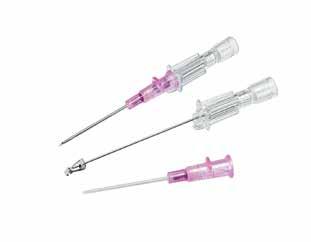



B. Braun Medical Inc. | Bethlehem PA | 800-227-2862 | bbraunusa.com * B. Braun Data on File. Rx only. ©2024 B. Braun Medical Inc., Bethlehem, PA. All rights reserved. 24-0070_1/24
Scan for eIFU and more information
that decision process, so we have established a care pathway for nursing and physicians to evaluate specific aspects of their health to make decisions. This pathway applies interventions, such as early mobilization and intense discussion on what matters, so that we can determine if the patient would be best served by admission or by care outside of the hospital.”
Dr. Wintz began her surgical training in 2006 in a large metropolitan city, where most of the patient population was young and injured in car accidents, motorcycle accidents, or stabbings and shootings. “It was rare for me to care for someone over the age of 65,” she says. “As the years of training went on and I matriculated into my own practice in another state, the population also started to change. Although I was still managing mostly young patients with major injuries, I started to notice an [increase] of a much older population. Trauma surgeons across the nation were seeing older patients, and their practices had to evolve to accommodate the volume and the intricacies of the care needs.
of the program despite initial hesitation. Breaking down barriers, integrating silos, changing culture, and maximizing trust and partnership have required constant commitment. The Generational Health team has taken this seriously and has inspired excitement and interest at a very difficult time in healthcare. We are fully invested in the process because we have seen overwhelming success in terms of outcome and a spreading equality for the most vulnerable group of patients.”
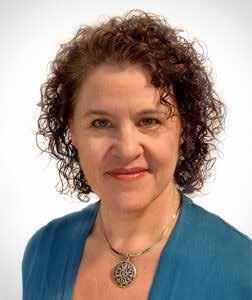
‘ The best outcomes occur when care is coordinated, connected, and individualized wherever it occurs – clinic, emergency room, hospital, lab or office.’
“I started to grow an interest in caring for the older population. It was a new challenge for me –managing the underlying diseases, talking about issues relating to end of life, addressing changing levels of independence, and putting the medical care into the context of that patient’s goals for self. Patients 65 and older now encompass a third of my practice.”
The success of Sharp HealthCare’s generational program rests on culture change across the health system, including primary care, says Dr. Wintz.
“Our main strength is the institution of cultural change in providing healthcare to older adults. Surgeons and providers across several specialties have openly commented on their appreciation
Speaking of the Sharp HealthCare/West Health partnership, West Health Institute Chief Medical Officer Zia Agha, M.D., told Repertoire in an email, “We have a rapidly growing and diverse aging population both in California and across the nation, and chronic disease and other issues travel with age and span the care continuum. Programs like this one are structured to break down the silos and approach issues holistically and are already being embraced by physicians, other health professionals, hospital personnel and patients. The best outcomes occur when care is coordinated, connected, and individualized wherever it occurs – clinic, emergency room, hospital, lab or office – and that is what we’re setting out to do with our partnership.”
RUSH
RUSH, a Chicago-based healthcare system comprising four medical centers and hospitals as well as over 140 physician practices, is an IHI-recognized Age-Friendly Health System. Through the RUSH Center for Excellence in Aging, the system is working to incorporate the 4Ms in some of its clinics and across the health system.
“Identifying and documenting what matters to an older adult is challenging for RUSH and most other health systems,” says Erin E. EmeryTiburcio, Ph.D., ABPP, co-director of the Center for Excellence in Aging. “Having conversations about what is most important and assuring that the care plan is consistent with what matters takes time and is challenging to fit into tight primary care windows.”
Repertoire www.repertoiremag.com 28 March 2024 ‘Age-Friendly’ Care Takes a Continuum
Erin E. Emery-Tiburcio, Ph.D., ABPP
The RUSH Center for Excellence in Aging recently revised the Medicare Annual Wellness template in its systemwide electronic health record to reflect the 4Ms, she explains. In addition, the 4Ms have been built into RUSH’s Virtual First clinic, which provides telehealth services and some in-person services as needed. “[E]very patient seen in the clinic has the 4Ms addressed, reducing inequities in standard primary care,” she says.
Because age-friendly care rests on patient input, RUSH Center for Excellence in Aging has developed tools such as patient brochures to help older adults think about and communicate what
matters to them. “We are also partnering with our Virtual First clinic and Rush Generations older adult council to enhance the tools they use to assess What Matters via the patient portal,” says Emery-Tiburcio. To help support its healthcare teams, RUSH offers them continuing education about the 4Ms and is working to integrate the 4Ms into the colleges in RUSH University as well.
“Our goal is that every student and every clinician at RUSH will implement the 4Ms with every older adult in our health system. We have a way to go to get to that goal, but the RUSH Center for Excellence in Aging is committed to that endeavor.”
The patient’s part in ‘age-friendly’ healthcare
Without patients’ active participation, there’s no way their care can reflect the 4Ms of the Age-Friendly Health Systems initiative – What Matters, Medication, Mind and Mobility. Chicago – based RUSH gives its patients tools, including brochures and a patient portal, to help them direct their care. Here is verbiage from RUSH’s brochure, “Better care for adults ... It starts with the 4Ms.”
What Matters
As you age, your needs might change. No matter what’s going on, you are the person who should decide what’s best for your health.
What You Can Do
Make a list of questions to ask at each visit.
Make sure you agree with everything in your care plan.
Make sure your providers have copies of your Healthcare Power of Attorney form.
Medication
You might take many medicines now, which can mean more side effects. Some drugs affect us in new ways as we age, too.
What You Can Do
Talk with your provider. Make sure you need all of your medicines. Make sure you understand the side effects too.
Ask how medicines interact with each other.
Tell your providers about any over-the-counter medicine or natural remedies you take too.
Mind
Older adults are at risk of dementia (losing mental abilities over time) or delirium (sudden confusion). Depression (ongoing sadness or loss of interest) can be a problem too.
What You Can Do
Get screened for dementia and depression yearly.
To avoid delirium, take medicines as prescribed. Watch for infections, which can cause confusion too.
If you become confused suddenly, get help right away. Sudden confusion is a medical emergency.
Mobility
It’s also important to think about how to get around safely as we get older.
What You Can Do
Talk with your providers about how you get around at home or go from place to place. What’s working or not?
Ask about exercises to get strong, flexible, and improve balance.
Check your home for rugs or missing handrails that can cause falls. These safety problems are easy to fix.
Source: “Better care for adults ... It starts with the 4Ms,” RUSH, https://catch-on.org/wp-content/uploads/4Ms/4MsPDFv3/HTML5/4MsPDFv3/4MsBrochure.html
Repertoire www.repertoiremag.com March 2024 29
How Do Your Physician Customers Get Paid?
Here’s
what you should know about how your physicians approach employment contracts
 Before signing anything, physicians should clearly understand all the provisions of their employment contract and judge whether they reflect what is most important to them personally and professionally, says Steven P. Furr, M.D., FAAFP, president of the American Academy of Family Physicians. “And the bottom line is, a verbal agreement is only as good as the paper it’s written on.” Repertoire recently asked Dr. Furr to respond to questions about physician contracting. Here are his responses.

The basics
Repertoire: What percentage of physicians are employees today? How many have written contracts in place?
Steven Furr, M.D.: Currently, about 75% of AAFP members are employed. More than half of that 75% are employed by a hospital or health system. Just under half are employed by physicianowned groups or other entities like community health centers or the Veterans Administration. We are not aware of any common practices where physicians are employed without contracts.
Repertoire: Does practice ownership (i.e., independent, corporate, health system, private equity) affect physician contracting?
Dr. Furr: Employment contracts with private practices or physician-owned groups may include an option for future equity. Such contracts should include a date by which to expect the option to become an owner; benefits,
Repertoire www.repertoiremag.com 30 March 2024 Trends
Steven Furr, M.D.
voting rights, and compensation for owners; and expected cost of becoming an owner. Physicians should insist the contract not terminate immediately if equity is not offered or if there is a delay. If this provision is not included, the physician could be left working without a contract in the event the practice delays or does not offer ownership equity.
Physician compensation
Repertoire: Compensation can come in various forms, such as salary-only, salary plus bonus, and productivity-based. How widespread are each of these three approaches today?
Dr. Furr: In a recent survey, AAFP members shared the most common components of their compensation as base salary, bonus, and productivitybased compensation. A majority reported their bonuses were based on quality performance. Anecdotally, members report to us that improvements in payment to their employers are not being passed along to employed physicians.
Repertoire: Of the three compensation models, “salary-only” would seem to be the least risky and “productivitybased compensation” the riskiest. Would you agree?
Dr. Furr: Compensation for family physicians should align with the value provided by primary care’s four core functions (the 4Cs): first contact, continuity, comprehensiveness and coordination of care. It should be based on meaningful quality, value and patient experience rather than productivity. Financial incentives should align with what matters most to patients
and their family physicians, as well as the movement toward well-designed value-based primary care payment models.
While “salary-only” is theoretically less risky, it also has the least opportunity for additional financial rewards from either bonuses or greater productivity. Employed family physicians may keep that trade-off and their risk tolerance in mind when choosing and negotiating the salary structure they want.
overall compensation. [CGCAHPS is the Consumer Assessment of Healthcare Providers and Systems from the Agency for Healthcare Research and Quality.]
We believe a much better measure is the new Person-Centered Primary Care Measure (PCPCM) from the AAFP, which is a patientreported outcome performance measure focused on the unique value of primary care. It focuses on aspects including accessibility, continuity, comprehensiveness,
‘An unintended consequence of paying based on RVUs is that physician groups may encourage physicians to see more patients per day at the expense of longer, more quality-focused visits with patients.’
Organizations should ensure their salary structures, levels, benefits and policies of the compensation package foster internal equity and reflect the family physician’s leadership of the care team.
Repertoire: Earlier you commented that “patient experience” might be one component of a compensation package. How successful are today’s practice owners in incorporating patient experience in compensation?
Dr. Furr: There is no straightforward answer. Each physician practice can choose whether to include patient experience metrics in the compensation package it offers to its employed physicians.
Some health systems and/or practices include one or more of the CG-CAHPS measures in their compensation packages, albeit representing only a small fraction of the primary care physician’s
coordination, advocacy, family and community context, and goal-oriented care.
Who determines productivity?
Repertoire: Can you elaborate on how “productivity-based compensation” arrangements typically work?
Dr. Furr: According to the New England Journal of Medicine, productivity-based compensation models are when physicians are paid a percentage of either billings or collections, or they are paid based on the resource-based relative value scale (RBRVS) RVUs assigned to services. The overhead costs of the practice – both fixed and variable – are allocated among the physicians. Even ostensibly “salary-only” arrangements may have a productivity component requiring the physician to generate a certain number of RVUs,
Repertoire www.repertoiremag.com March 2024 31
Trends for example, to earn his or her salary, and paying a higher salary if the physician generates RVUs above a given threshold.
Repertoire: What are the primary shortcomings of measuring productivity in terms of RVUs?
Dr. Furr: One limitation of using RVUs is their dependence on accurate CPT coding. Productivity measures for physicians who code incorrectly don’t reflect the actual work they do. Further, RVUs, like traditional productivity measures (e.g., number of encounters, billed charges), are geared toward a fee-for-service environment. They may not work as well in capitated and other environments in which generating patient encounters and CPT codes is not the emphasis. Lastly, RVUs tend to favor procedural services over “cognitive” services such as evaluation and management services, which means physicians who do more procedural services may be viewed as more “productive,” whether they are or not on other bases.
An unintended consequence of paying based on RVUs is that physician groups may encourage physicians to see more patients per day to meet network goals at the expense of longer, more quality-focused visits with patients. If we want to avoid going back to the age of seeing 30-40 or more patients a day, we would not support productivity-based incentives.
What makes up a work week?
Repertoire: Can physicians control or limit the number of patients they must see per day, week or month?

Dr. Furr: Employment contracts typically outline expectations for patient-care hours but not the number of patients seen or the size of a physician’s patient panel. The size of a physician’s patient panel and the number of patients seen in a typical day are likely to change during their career and may vary based on multiple factors, including the age, health status, and social determinants of health of the practice’s patient population. A more common measure of productivity is RVUs, as mentioned above.
An employment contract should provide a clear picture of what work life will be like, including schedule, patient care and administration hours, scheduled flexibility, additional duties, supervision, and call. Red flags to look for are requirements for
patient care hours of 40 hours per week and employment expectations that don’t align with verbal promises made during the interviews and negotiations.
Repertoire: AAFP cautions against contracts that call for a minimum number of patient hours per week while allotting no time for administrative work or other tasks. What are the key issues involved?
Dr. Furr: Many contracts state physicians must devote most of their hours directly to patient care. However, these contracts don’t consider the amount of time spent on administrative tasks or the burden that comes with them, including electronic health record entries, tedious prior authorizations, referrals, paperwork and reviewing test results.
Repertoire www.repertoiremag.com 32 March 2024

‘An employment contract should provide a clear picture of what work life will be like, including schedule, patient care and administration hours, scheduled flexibility, additional duties, supervision, and call.’
According to research from the Medical Group Management Association, nearly 90% of physicians found prior authorizations to be very or extremely burdensome. Moreover, 97% of physicians reported their patients experienced delays or denials for medically necessary care due to prior authorization requirements. That’s why it’s imperative for physicians to ensure any contracts consider administrative tasks together with patient care.
How do bonuses work?
Repertoire: How clearly should the basis for bonuses be spelled out in the contract?
What are red flags for the physician to look out for?
Dr. Furr: Bonuses should be spelled out as clearly as possible in contracts. With a staggering physician workforce shortage, physician recruiting has become highly competitive. To attract physicians, some employers may offer bonuses, including a signing bonus. Physicians need to be
sure they clearly understand how their termination (voluntary or otherwise) could impact bonuses and any required repayment.
Repertoire: You referred to bonuses based on quality performance. In your opinion, how successful are today’s practice owners in 1) defining quality performance, 2) monitoring it and 3) rewarding physicians on the basis of it?
Dr. Furr: For bonus compensation purposes, each physician practice can choose to define “quality performance” however it seems appropriate for the population it serves and the priorities of the clinic, which are often driven by multiple payer contracts. For example, some health systems choose a few quality/ performance measures internally and tie those to compensation incentives for their employed physicians. Sometimes the primary care physicians have a “say” in which measures are chosen, and sometimes they do not. (In some cases, health system administration chooses the measures without input from the employed primary care physicians.)
That said, quality measures are not set in stone. They can change. Quality measures and goals in contracts may be set one to two years out, but if recommendations change and are not incorporated into an electronic medical record, confusion can result when trying to define a contract goal for incentive. The contract may say one thing and the EMR is now measuring differently.
Monitoring quality performance varies by physician practice/organization, as well
Repertoire www.repertoiremag.com March 2024 33
as the capabilities of the clinic’s electronic health record system. Many practices have an EHR system that displays a performance “dashboard” so physicians can view their “performance” on a variety of measures in real time. However, the lack of interoperability across healthcare systems and settings presents a challenge. The performance dashboard that primary care physicians view in their EHR system often includes only data from patient care that was provided in their own clinic or health system [but not] outside of the primary care practice or healthcare system. This creates limitations in using the data for performance measurement.
‘ Compensation should be based on meaningful quality, value and patient experience rather than productivity.’
Rewarding physicians based on performance can also vary greatly by physician practice/ organization. As the healthcare landscape continues to shift from fee-for-service to a heavier focus on value-based care, we’ll see a growing number of physician practices that offer performancebased compensation for their employed physicians. [But] the limitations on defining and monitoring quality performance also limit the effectiveness

of rewarding physicians based on quality performance.
Termination and non-competes
Repertoire: Under what circumstances can a contract be terminated?
Dr. Furr: Termination of a contract is always a possibility, but it’s something that physicians try to avoid. Before taking action, I recommend they ask themselves a few questions: “Do both parties have the right to terminate?” “Will I receive written notice?” “Is there a possibility of fixing the issue before termination occurs, like a performance improvement plan?” Additionally, it’s critical that physicians know their exit strategy. Since termination of an employment contract can impact insurance, bonuses, loan forgiveness and non-compete clauses, it’s important to be aware of exactly how a physician can terminate an agreement. A lawyer can help navigate these waters.
Repertoire: Where do practice owners stand on noncompete clauses today?
Dr. Furr: The most important thing I want to emphasize is that noncompete agreements in healthcare employment impede patient access to care and disrupt care continuity. A 2018 survey found that about 45% of primary care physicians in group practices were bound by noncompete clauses.
Repertoire www.repertoiremag.com 34 March 2024
Trends
By stifling competition and limiting physicians’ ability to choose their employer, noncompete provisions have significant consequences on the healthcare workforce. For instance, with fewer clinicians, patients may have to wait longer to receive care or travel farther to access critical services. The result can be worse health outcomes and a less efficient healthcare system. Noncompete agreements also contribute to burnout and mental health struggles by forcing clinicians to remain in unsustainable work environments or risk losing their livelihood or uprooting their families.
Repertoire: Do the non-compete provisions in today’s contracts differ from those of 5 or 10 years ago?
Dr. Furr: I think it’s important to take a closer look at how noncompete clauses can significantly impact a physician’s life, especially when coupled with growing healthcare consolidation. For instance, when a large employer with a sizeable geographic footprint imposes geographic radius as a noncompete provision, the physician may have to go out of state or to a new region. In other words, they may have to uproot their lives to continue to practice medicine.
Repertoire: How do young physicians differ from their predecessors in their approach to employment contracting?
Dr. Furr: Young physicians and their predecessors are increasingly choosing employment over starting their own practice. Almost 90% of AAFP New Physician Members are employed. We don’t yet have a clear answer to the drivers of this trend, but burnout and student loan debt may be contributors. Additionally, younger physicians may like the parameters of being employed by a practice, such as set hours, set vacation and CME packages.
negotiations and before signing. It’s also critical to identify what is most important to them and focus on those crucial factors in negotiations. My hope is that our next generation of physicians will take the time to review their contracts and identify the most important items to negotiate and ask for provisions that will ensure they’re satisfied professionally so we can continue to provide the best care to patients.
Repertoire: What do physicians wish their sales reps knew about physician contracts?
‘ It’s imperative for physicians to ensure any contracts consider administrative tasks together with patient care.’
That said, it’s important for physicians to equip themselves with knowledge and prepare to negotiate. There is a lot that physicians can negotiate for that they often don’t because they’re either too afraid to ask or they don’t even consider it within the realm of possibility.
So, my advice continues to be, know your worth and be informed. Physicians need to fully understand any employment contract before going into
Dr. Furr: For employed physicians, the contract plays an important role in career success. If a misunderstanding emerges during employment, you cannot rely on verbal promises and written correspondence (e.g., letters or emails). Only the terms spelled out in your contract matter. That’s why understanding how to negotiate your employment contract is essential to achieving professional satisfaction and personal fulfillment.
Editor’s note: The AAFP has developed resources to help physicians learn more about employment contracting, including a career benchmark dashboard equipped with comprehensive compensation and job satisfaction data. AAFP members can use this dashboard to see how their income, benefits, career satisfaction, and more compare to peers in similar roles by state.
Other AAFP resources include:
AAFP Guiding Principles for Value-Based Payment, www.aafp.org/about/policies/all/value-basedpayment.html
Measure what matters in primary care: The Person=Centered Primary Care Measure, www.aafp.org/pubs/fpm/issues/2022/0300/p17.pdf
Repertoire www.repertoiremag.com March 2024 35
Who Do You Want to Be in this Ever-Changing Environment?
It’s a question Cardinal Health’s Jill Amicone asks herself as a leader and her team as it works to help health system providers strategize and prepare for the future.
 If you had asked Jill Amicone what it took to be identified as leadership material in an organization, she may have had a different answer earlier in her career. But today, as Vice President of Nursing Care Products Sales for the U.S. Medical Products and Distribution business at Cardinal Health, she said she’s learned to identify top talent by an individual’s ability to be flexible and adaptable – to changing market conditions, customers’ needs, supply chain disruptions, and technology innovations.
“Some of that is because of the pandemic, but really I think it’s always been a part of what we do,” Amicone said. “Nothing is constant in our market. Whatever my day looks like when I wake up at 5 a.m. is not what it will look like when I finish.”


Good leaders are always looking for different opportunities and solutions – and for team members to take the initiative in their own hunt for those solutions. “They can come from anywhere in your organization,” she said. “I promised my team that I would stop using the word ‘pivot,’ but we have to be able to pivot in our marketplace and adjust our strategy to respond to our customers and support their priorities.”
When team members see a leader who can adapt confidently to whatever’s happening in a changing marketplace with shifting
Repertoire www.repertoiremag.com 36 March 2024 Leadership
Jill Amicone
circumstances, they’re inspired by that person and are more assured in what they’re doing day-to-day.
Amicone said leaders must have integrity to effec tively lead a team or organization. “When your team sees honesty and transparency [amid difficult circum stances], they are more engaged and committed to what they’re doing for our organization and customers.”
Changing behaviors
Throughout the pandemic, the purchasing patterns and behaviors of U.S. healthcare providers were dif ferent. They had to be. But what Amicone has been excited about over the last 6 to 12 months is partner ing with customers and clinical end-users in figuring out who they want to be in this post-COVID pan demic world. “On the one hand, you have customers who want to diversify their suppliers,” she said. “But on the other hand, you have customers who want to reinstate standardization efforts and really get back to one supplier or one technology solution to support clinical needs. I find it energizing, and I think my team does too – being the right solution for our customers.”
Transparency in today’s discussions with cus tomers is paramount. Prior to the pandemic, supplier-provider conversations didn’t necessarily cover supply chain visibility and a customers’ initia tives or goals from RFP or trial. Were they looking to go to multiple suppliers, or was standardization the priority? “Now we’re going into those conversations really with an idea of what they’re looking for in a partnership and supply relationship.”

Success beyond numbers
Seeing improved clinical outcomes with Cardinal Health’s products is a good key performance indicator for leaders to track. “Numbers would obviously come along with that, but if you recently placed a product with a customer and you see the customer achieving goals, whether it’s lowering catheter-associated urinary tract infection (CAUTI) rates, or reducing surgical site infections, needle sticks, whatever it may be, if you start to see a customer hit their goals, that’s very rewarding and another way to measure success.”
Outside of hitting financial goals, Amicone said she measures success as a leader in the retention, development, and promotion of team members from within, particularly with anyone who has been identified as top talent. “There’s nothing more rewarding than seeing your top talent secure the next role in their career aspirations,” she said.
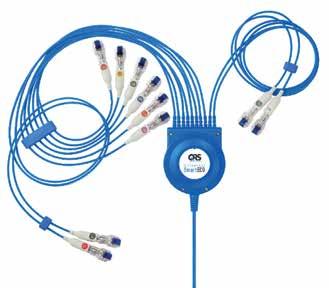
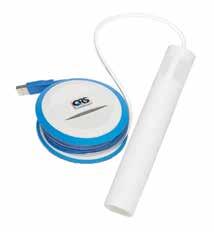


Great Opportunities for Growth
As the aging population continues to grow and consumer preference moves away from institutional care, Cardinal Health’s Ryan O’Connor leads his team into new markets. By
Daniel Beaird
 Ryan O’Connor is the National Vice President for Extended Care within the U.S. Medical Products and Distribution business at Cardinal Health, where he started as a rep in Orange County, Calif., 14 years ago.
“The growth in extended care has been fueled by a growing number of procedures shifting from acute hospitals to ambulatory surgery centers (ASCs) and more patients recovering or seeking care at home,” O’Connor stated. “Also, higher acuity diseases or treatments that would have taken place in the hospital setting are now finding themselves at home. It’s definitely a shifting dynamic and products going into home care are increasingly more focused on disease states that are more complex.”
O’Connor says it’s a good opportunity for Cardinal Health to grow in the space. Just this past year, Cardinal Health launched a new enteral feeding device under Kangaroo brands. “Kangaroo OMNI™ is the next generation of enteral feeding focused on improving patient outcomes and quality of care. We launched the new device in August of last year to our sales team in Nashville. They were energized by what they saw, and the way our team has rallied around the product is a differentiator,” he said. “It’s clinically differentiated in the market
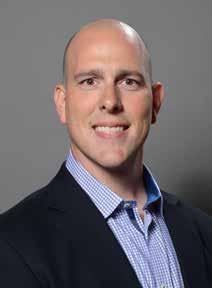
and drives for differentiation and patient outcomes.” Cardinal Health has had positive momentum getting that product launched and achieving market awareness across providers, caregivers and patients, according to O’Connor. “We have a diverse product basket of Cardinal Health Brand products that range from physician-preferred core products and supplies to highly clinically differentiated specialty products,” he said. “And when you get to bring a device to market at the forefront of clinical differentiation, it’s a lot of fun.”
Relationship building and understanding customer needs
When you’re in a business that is product driven, O’Connor says nothing is more important than relationship building and understanding your customer’s needs. That’s a key trait in his teams. “A lot of people are part of large organizations that are highly matrixed, and you have to build internal relationships to achieve your business goals,” he said. “When I’m trying to elevate someone to a regional director position, I try to get a sense if they are actively engaged and actively learning. Are they good at building relationships both internally and externally to move forward?”
He’s looking for team members who are sponges and interested in learning about things they didn’t know because he says people in healthcare have to wear different hats than they had to five to 10 years ago. “You have to learn new spaces, new products and new roles.”
O’Connor tries to do those things right in order to develop
Repertoire www.repertoiremag.com 38 March 2024 Leadership
Ryan O’Connor
as a leader himself. He took on his current role over two years ago when it was focused on post-acute care, which is longterm care only. But his team has recently taken on home care and combined it with its long-term care business. “And just like that, I’m trying to learn as much as possible,” he said. “Making sure I’m keeping up with high-end data and market intel, learning from our customers and asking questions is important, especially in a unique and dynamic market such as home care.”
He asks home care providers and distributors about their challenges. What are they facing? What are some of the gaps in service that Cardinal Health can help fill?
Cardinal Health’s defined values and behaviors and tackling new technology
“I’m pushing myself in this role to learn and grow, and there’s a lot of similarities between what I expect of both me and my team,” he said. “Cardinal Health has a defined vision for our values and behaviors. So, leaders across the organization often begin their calls in a similar fashion. From the frontline worker to the senior executive, we’re driving the same values and behaviors across the board.”
O’Connor says having that synergy helps Cardinal Health achieve success, and it resonates with him and his team.
“Cardinal Health allows its people to bring their full selves to work every day. It’s a talk-the-talk

and walk-the-walk perspective and I value that,” he added. “I’m trying to bring diversity to my team from experience to culture. Our organization has created a space where all team members and their contributions are valued.”
O’Connor measures success with his team outside of just the numbers. He looks at retention and thinks about it in two ways: retention of the team and retention of customers. “Are employees happy? Do they enjoy coming to work? Are they turning down opportunities when recruiters are calling? There’s a lot of opportunities to change organizations, so if our people are choosing to stay, that’s a great measure for success,” he said. “For customers, if we’re providing the right service and being valued business partners, while helping them accelerate their growth and achieve their business goals, then we’re doing a good job.
“As a frontline rep, our teams are in the best position to best understand solutions for new technology, AI or anything else, as it all begins with understanding customer needs,” he continued. “There are going to be a lot of opportunities for organizations to get on board with AI; if they can truly understand customer needs and act fast, they will find success. And reps are trying to figure out where they fit in to the different changes in the market. For my team, I’m talking a lot about how we can address quality, cost and speed of care, whether it’s in a nursing home, working with a home health agency or a DME provider. The companies that rally their teams behind customer needs and think creatively around these new technology solutions will be the ones that bring new ideas to market.”
Repertoire www.repertoiremag.com March 2024 39
Words to Live By
Julee Prefer believes putting the needs of others first allows us to align our efforts to the success of all.
 Cherish every connection you make. That’s the advice Julee Prefer would give to her younger self. Cherish the connections, and welcome differences and differing viewpoints that come along the way in your professional journey. “Be willing to put the needs of others or the team ahead of your own,” said Prefer, President of Healthcare Solutions, and the 2023 recipient of Professional Women in Healthcare (PWH) Anne Eiting Klamar Leadership Award of Distinction. “If a relationship is not win-win, no one wins. Know that the skills you attain will transfer to far more applications and positions than you ever imagined. Be willing to take risks. Pay forward and give back.”

Repertoire www.repertoiremag.com 40 March 2024 Leadership
Prefer learned the value of giving back through her first promotion. The experiences gained changed the way she viewed leadership, she said. It was not the role or title of the position that impacted her but rather being humbled by the accountability to develop, empower, and support those on her team along their career path.
A second pivotal moment that shaped her view of leadership was the launching of Professional Women in Healthcare (PWH). Women from across our industry at

various levels of their career came together to give freely of their time, talents, and experience to lead not a team or a company but an industry.
“This was and is a powerful movement that is transforming our industry,” she said.
Prefer said she measures success for PWH as empowering women in the industry to rise to their full potential personally and professionally, which will lead to accomplishing the PWH vision of an industry equally led by women. “In accomplishing this, we make our industry stronger and better,” she said. “It has been amazing to see PWH grow, not only in number of members, partners and our offering, but in the number of women empowered to rise to the next level.”
Making the leap
Prefer said that as a sales rep (producer), the focus is on individual contributions even though you appreciate and support the team.
But the step into leadership is a complete transition to outward focus. It is no longer about your individual accomplishments, but rather about aligning you and your team’s efforts to the corporate or common goal. “It is about seeing the strengths in each individual member of your team to develop and support their growth and
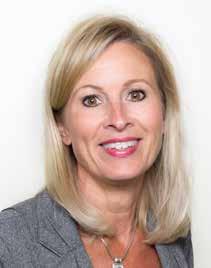
contribution while integrating the strengths of the various team members,” she said. “The focus of your career becomes the development and empowerment of others.”
Intentionality
The biggest challenge in today’s marketplace has been the constant state of change and transition in the med/surg supply chain, whether from internal or external forces.
“It has required us to be intentional about staying focused, quick to massage the tactics we employ to meet our goals, and adaptable as we continually transition our skills to new landscapes and new roles,” she said. “In the end, I believe that these challenges have made us much stronger.”
What traits will it take for sales teams to succeed in today’s marketplace? Prefer listed a few:
The ability to think outside of the box (A box which seems to be disintegrating before our eyes).
Repertoire www.repertoiremag.com March 2024 41
Resilience Flexibility
to team
Servant leadership Commitment
Julee Prefer
Privia Health drives growth through its five core services, recently signs on to more tech-based partnerships
The commercially traded healthcare provider has expanded its footprint to over 1,000 practice locations in the U.S.

 Privia Health’s first practice went live more than 10 years ago in August 2013 with Internal Medicine Associates of Reston in Reston, Va., and it began trading on the Nasdaq Global Select Market in May 2021. Today, the network and tech-enabled commercial healthcare provider (CHP) has over 4,100 providers and 1,000 practice locations in its purview serving over 4.7 million patients. Its stated mission is to transform the healthcare industry by empowering physicians, enhancing the patient experience and driving better outcomes by partnering with independent providers to help navigate the transition to value-based care.
Privia Health’s five core services
Privia Health strives for better outcomes in valuebased care through its five core services, including:
Technology and population health.
Management services organization.
Single-TIN medical group.
Accountable care organizations.
Network for payers and purchasers.
Repertoire www.repertoiremag.com 42 March 2024 Commercial Healthcare Providers
Technology and population health: Privia Health’s tools are designed to enhance independent providers’ workflow. It aims to optimize practices’ web presence so patients can easily find a provider online and receive appointment reminders to fortify patient retention and avoid no-shows. It embeds insights directly into its EHR so providers can assess both patients’ health and practice performance. Its technology sends risk adjustment factor and care-gap reminders to improve workflows and the patient experience. Finally, it supports treatment with patient education tools, transitional and chronic care management, and care plans.
Management services organization (MSO): Privia Health’s MSO aims to leverage its scale to reduce administrative work, increase efficiency and lower direct costs for providers through revenue cycle management, performance management, analytics and reporting, clinical IT, IT support and marketing.
Single-TIN medical group: Privia Health’s medical group allows providers to adapt to serve their patients’ and region’s unique needs and harness the single tax entity for negotiating power, clinical integration and alignment of financial incentives. Providers in Privia Health’s medical group collaborate in physician-organized delivery meetings to review analytics, share best practices, create accountability and advance evidence-based medicine while maintaining their autonomy. Providers can reduce expenses by using Privia Health’s ancillary services and access group purchasing discounts.
Accountable care organizations (ACO): Privia Health’s proprietary, cloud-based technology platform aims to identify quality gaps, send patient satisfaction surveys, automate patient outreach and education, and generate reports and alerts to improve care coordination. It collects data from payers, providers and patients to advance population health and streamline physicians’ workflows.
Medical Group Gulf Coast’s OB-GYN providers’ weight management offerings.
It also announced an agreement in November 2023 with Calm Waters AI, a fully autonomous AI Evaluation & Management (E/M) coding application for providers. Provider groups affiliated with Privia Health can implement and use Calm Waters AI at a discounted subscription rate as the software solution is
Provider groups affiliated with Privia Health can implement and use Calm Waters AI at a stress associated with E/M coding through speed, compliance and standardization.
Network for payers and purchasers: Privia Health’s networks helps providers connect with new patient populations, create custom contracts for better value and integrate with the community. Its contracting services look to leverage data and physician input to help providers grow their patient base and influence care. It works with health systems to increase alignment of employed and independent physicians to optimize resource utilization through its clinically aligned model.
Privia Health expands market footprint, signs partnership agreements with AI-based tech enablers Today, Privia Health serves 15 markets across the U.S. and launched an OB-GYN initiative in Texas in December 2023 called Privia Wellness that utilizes techenabled women’s health company Iron Health to support Privia
designed to eliminate clinician stress associated with E/M coding through speed, compliance and standardization. That followed an agreement in September 2023 with Navina, an AI-powered primary care platform that aims to transform complex, fragmented patient data into actionable insights at the point of care.
And after appointing former President and COO Parth Mehrota as CEO in June 2023, Privia Health entered a partnership with Velocity in July 2023 to embed clinical research into practice sites. It builds on Velocity’s embedded site model strategy and expands access to clinical trials for Privia Health patients and providers. With the first site opening in Abilene, Texas, the partnership is intended to establish integrated research sites within existing Privia Care Center locations that do not currently conduct clinical trials. Velocity will staff and operate the joint research sites.
Repertoire www.repertoiremag.com March 2024 43
CHPs in the News
CVS Health, Ohio State Wexner Medical Center form ACO
The Ohio State University Wexner Medical Center and CVS Accountable Care, part of CVS Health®, announced the creation of an accountable care organization (ACO) to improve the quality of care for Medicare beneficiaries by Ohio State providers in central Ohio. This coordinated approach to delivering care is centered around each patient’s unique needs and emphasizes preventive wellness and proactive treatment of chronic conditions.
The new CVS ACO, LLC (CVS ACO), a Medicare Shared Savings Program (MSSP) Enhanced track ACO, expands the Ohio State Wexner Medical Center’s ACO work and furthers both organizations’ focus on improving people’s lives and providing patients with the right care at the right time in the most appropriate care setting. The CVS ACO will combine resources from both organizations to provide more patients with care coordination and longitudinal care management to address both medical and social needs.
“As we prepare for the nationwide shift to having all Medicare beneficiaries in accountable care relationships by 2030, this collaboration with CVS Accountable Care is a natural progression of Ohio State’s work in this space
that builds on our commitment to provide the very best care to every patient, every time,” said John J. Warner, MD, CEO of The Ohio State University Wexner Medical Center and executive vice president at Ohio State. “It’s important that we meet every patient where they are in their health care journey and take the next step in being accountable for our patients’ holistic health and improved outcomes.”
To give patients high-quality, coordinated service and care, the Ohio State Wexner Medical Center and CVS Accountable Care clinical
care teams will focus initially on supporting the transition of care for all ACO beneficiaries following a hospitalization, providing medical and social support services for beneficiaries with higher risk of hospitalization or readmission, and strengthening comprehensive care management for all ACO patients. Patients will benefit from increased touchpoints from a clinical care team member, including education regarding complex medical conditions, assistance with scheduling follow-up visits, and access to community resources.
ChenMed names Steve Nelson CEO, Chris Chen Executive Board Chair
Chris Chen, ChenMed’s Chief Executive Officer, will transition to the role of Executive Chair of the Board. Steve Nelson, the company’s President, will elevate to serve as ChenMed’s CEO, leading management and operations. Mike Redmond, ChenMed’s Chief Financial Officer, will remain at ChenMed and transition to the role of Special Advisor to the CEO and Board of Directors. Mike Bruff, the company’s Executive Vice President of Finance will elevate to serve as Chief Financial Officer. “My father’s vision for the company and our family’s commitment to bring our model of health care to those who need it most is now enabling hundreds of thousands of people to live healthier, more secure lives,” said Chris Chen. “Steve Nelson’s expansive knowledge of health care, his skill in executing against a value-based care model, and his leadership values will position him as CEO to help us reach more people who can benefit from ChenMed’s brand of better health and well-being.”
Repertoire www.repertoiremag.com 44 March 2024 Commercial Healthcare Providers
CMS Behavioral Health Program
CMS announces new model to address the national behavioral care gap
 Behavioral health conditions significantly impact the Medicare and Medicaid populations, with 25% of people with Medicare experiencing mental illness, and 40% of adult people with Medicaid experiencing mental illness or substance use disorder, according to the Centers for Medicare and Medicaid Services (CMS). High costs for care, lack of access to quality behavioral health treatment, and fragmented care systems often make it difficult for individuals to receive the proper behavioral care that they need. According to CMS, this is especially true for historically marginalized racial and ethnic groups, low-income populations, and individuals living in rural areas.
The U.S. Department of Health and Human Services, through the Centers for Medicare and Medicaid Services (CMS), is announcing a new model to address the national behavioral care gap, called The Innovation in Behavioral Health (IBH) model. The IBH model is a new approach to improve behavioral and physical healthcare services for individuals with Medicaid and Medicare. The goal of the IBH model is to improve overall quality of care and outcomes for adults with mental health conditions and/ or substance use disorders.
The IBH model will connect individuals with the physical, behavioral, and social support to address their healthcare. Through interprofessional care teams, patients will have service integration that aims to bridge the gap between their physical and behavioral care needs. Regardless of how patients enter care, they will have access to all available CMS services, referred to as a “no wrong door” approach.
Practice participants in the redesigned IBH model will be Community Mental Health Centers, public and private practices, opioid treatment programs, and safety net providers that provide outpatient mental health and SUD services. The model’s goal is to integrate each practice along the process of screening, assessing, and coordinating individuals’ physical and mental health needs. Care integration will include person-centered treatment and planning of behavioral conditions, monitoring of
conditions, and care plan adjustments, according to CMS.
The IBH model will equip participating practices with the resources needed to collaborate care, such as through infrastructure payments in support of health center’s IT capacity, technical resources, and value-based payment models, coordinated through CMS.
The new IBH model builds on earlier CMS efforts to include behavioral health practices in health programming. The IBH model is based on the lessons learned from Innovation Center models including the Maternal Opioid Misuse Model, Integrated Care for Kids Model, and the Value in Opioid Use Disorder Treatment Demonstration.
The IBH model is planned to begin in Fall of 2024 and will operate for eight years in up to eight states. A Notice of Funding Opportunity, with further information on the model’s financial plan, will be released in Spring 2024 prior to the model launch.
Repertoire www.repertoiremag.com March 2024 45 Trends
Supply Chain Leader Spotlight
Martha
Bergstedt,
Vice President
Strategic Sourcing, Novant Health
Can you tell us about your role and responsibilities within your organization?
I am the Vice President of Strategic Sourcing and Contract Management for Novant Health. I have had this role for the last five years. I lead the team that’s responsible for contracting, but at the end of the day, it’s setting up the strategy for non-labor spend. We’re trying to understand the value propositions for all our third-party spend, whether or not it’s services, drugs, or supplies. My role is to empower my team to make the best decisions with their clinical and business owners. So, if they’re working well and getting the best value, then I figure my job is done.
What are some leading market forces impacting your Supply Chain team?
We can’t discount inflation. Then there are the post-COVID effects continuing to resonate within our health system.
Expenses need to come down, whether it’s in labor, contract, supplies, or drugs. In a normal timeframe, one of our goals in Strategic Sourcing is to reduce cost year over year. The unfortunate thing about the market forces we’re dealing with is that most of our third parties are unwilling or unable

to reduce costs unless there’s some kind of value proposition for them, which we have been able to find in many areas, but not throughout the whole industry. They are suffering from increased prices and increased
costs, therefore they’re trying to make sure they remain relevant.
But we’re trying to find that win-win, and not just in market share or growth year over year, which are the traditional levers. What are the key determinants for
Repertoire www.repertoiremag.com 46 March 2024 IDN Insights
Martha Bergstedt
each one of those industries that is important for our third parties? It hasn’t made our job more complex, just more time sensitive.
The other challenge is the constant internal pressure for resources. Layoffs are a reality for many health systems. We have to figure out a way to do what we do better. Picture a big river and a small dam. The dam has always worked because it lets a little trickle in while you’re constantly working on it, but what’s coming in now is much more. You are so busy trying to fix the short-term cracks in the dam but don’t have enough resources to handle the long-term, increased volume. It’s important to keep the team engaged and flexible to address priorities and emergencies, while building long-term solutions to support a completely different delivery of care
What projects or initiatives are you excited to work on?
ERP is something most healthcare systems are still trying to figure out. I was in manufacturing 15 years ago and we were going through an Oracle ERP implementation. In healthcare it seems like we’re just catching up. That’s what I think healthcare has been missing for a long time. There’s been a lot of emphasis on clinical support systems, but back-office supplies, systems that allow for efficiencies – whether or not that’s the basics of transactions, payments, purchase orders, etc. – all that has been neglected for a very long time for many of us. So, automation and increased efficiency are top goals for us. We’ve spent the last six months to a year deploying a new ERP system that will consolidate our
HR function, supply chain function, and financials. It should make things a lot more streamlined, reduce handoffs, and have less redundancies in the processes. It’s a short-term pain for a long-term gain. The go-live is next year, so we’ve got a little bit more work ahead of us.
a different place, and intentionally understanding what that means to help us make the best decisions for all parties.
Having practices to make sure I have diverse voices within my team when we’re talking about long-term planning, investing, or deciding
We’ve spent the last six months to a year deploying a new ERP system that will consolidate our HR function, supply chain function, and financials. It should make things a lot more streamlined, reduce handoffs, and have less redundancies in the processes.
In addition to technology, our next generation of clinical optimization excites me. We launched a process that further refines the value equation of outcome improvements compared to cost. We call it Precision. The goal is to build on the success of clinical variation reduction and look more holistically at care variation with the aim at improving health and reducing cost.
When you hear words like diversity and equity in the workplace, what does that mean to you, and how can they benefit an organization?
This needs to be at the forefront of most discussions. I think it’s best used to our advantage when we’re intentional about understanding it. Novant Health has done this for many years. We have used diversity and equity not as a program, but as a competitive advantage. This is the way we make decisions, by recognizing that everybody’s coming from
what type of vendor we work with. Diversity and inclusion are permeated through most of the decision making we have.
It’s important to me because at the end of the day, as a woman leader, I want to be in a company that I resonate with, where I see those values as important and we continue to talk about them, and that is certainly what we do.
How do you continue to grow as a leader?
Seeing the positive even in tough times. The incredible support I’ve gotten from my team and others has shown me that as a leader, it’s important to integrate their voice into decisions, and be transparent with the things I know and the things I don’t. This has catapulted us to be a lot better and more resilient. I grow and I take a lot of comfort out of having those individual conversations with team members, understanding where everybody else is.
Repertoire www.repertoiremag.com March 2024 47
Supply Chain Leader Spotlight
Roz Holloway, General Manager of Resource Optimization & Innovation, LLC (ROi)
Please tell us about your role/responsibilities within your organization.
As General Manager of Resource Optimization & Innovation, LLC (ROi), my primary role revolves around strengthening supply chain stability and mitigating global supply chain challenges. I achieve this with the invaluable support of an exceptional team
of healthcare professionals, each possessing expertise in various aspects of supply chain management, clinical practice, regulatory compliance, manufacturing, data utilization and global sourcing.
My responsibilities encompass the oversight of our three distinct brands: Regard ® Medical Supplies, Regard ® Clinical Packaging Solutions, and ROi Supply

Chain, in addition to my role in global sourcing through our international office. In this capacity, I am entrusted with ensuring the delivery of end-to-end supply chain solutions and anticipating disruption and regulatory impacts on our customers. This requires orchestrating a comprehensive approach that not only addresses their immediate needs, but also positions them for long-term success in the ever-evolving healthcare landscape or during disruptive periods. I often say, ‘Data should tell the story so we can help find a solution.’ My primary responsibilities focus on product companies, but we also use data to positively impact care at the bedside for caregivers.
In what ways has the supply chain changed what makes value analysis more important to hospitals and health systems?
I draw a clear distinction between value analysis and clinical operations. While many view value analysis as simply the introduction of new products, we perceive it as a journey that involves data, information, clinical expertise and the global supply chain to ensure we deliver the right solutions.
We regard value analysis as a core responsibility of clinical operations, emphasizing its crucial role in the healthcare supply chain and patient care.
Repertoire www.repertoiremag.com 48 March 2024 IDN Insights
Roz Holloway
As a provider-owned company, ROi is focused on making healthcare missions possible. Fundamental to that is ensuring clinicians and physicians have the necessary resources to provide the best care for their patients. We do this by taking a unique perspective that combines operations, clinical information and data.
Clinical operations continuously strengthen the link between products, usage, clinical efficiency and patient care. We’ve observed a growing interest among healthcare systems in engaging in discussions that go beyond individual products. Their focus is on finding ways to enhance clinician satisfaction and efficiency to elevate the overall patient experience. We are enthusiastic about our wellpositioned role in these discussions and playing a vital part in the continuum of patient care.
When you hear words like diversity and equity in the workplace, what does that mean to you?
How can they contribute to the success of an organization?
When I hear words like diversity and equity in the workplace, I think of two fundamental principles essential for fostering an inclusive environment. Diversity involves recognizing and celebrating differences among teammates, creating a mosaic of talents and ideas. Equity ensures equal access to opportunities, breaking barriers and acknowledges that fairness means providing what each person needs to thrive. These principles drive organizational success through innovation, diversity of thought, well-rounded decision-making, engaged employees and ultimately stronger customer relationships.
Embracing diversity and equity is not just a moral imperative, but also a strategic advantage for achieving organizational excellence. Embracing diversity of thought is a distinction I push within my organization.
Has anyone come alongside you to mentor you during your career? If so, can you tell us about that?
I have been very fortunate to be surrounded by a supportive family, friends, great leaders and inspirational colleagues and peers throughout my career. I have truly had a wonderful support structure throughout my life, from the classroom to the factory floor, then the office, and eventually the boardroom. I remember the line lead who taught me how to run a CNC machine at my first job out of college, and I am grateful for my current team and leaders whom I sincerely respect and appreciate. I fundamentally believe that people want to help each other, which I find inspirational. So, in turn, I carry this philosophy forward in all that I do to inspire those I work with.
If I had to pick one mentor, it would be my husband. We’ve been together since college, starting a family, going through life overseas and raising our two children into thriving adults. We’ve had many laughs and fun moments along the way. He is a great role model, and without his guidance, nothing would have been possible.
How do you focus on your growth as a leader?
As a thought leader, I focus on continuous learning, selfawareness and collaboration.
Staying well-informed about supply chain and environmental trends, as well as industry developments, is a priority and helps me adapt and lead effectively. However, a significant part of my growth comes from my team and colleagues. We have a brilliant group of individuals who are willing to share, collaborate and mentor. Frankly, they are the most important aspect of my growth, as they bring different perspectives to the table, leading to better decisions overall.
What project or initiative are you looking forward to working on in the next 3-6 months?
ROi has a unique culture and a team of professionals from both within and outside the healthcare industry. Our passion lies in solving supply chain challenges. The most satisfying reward for us is when we hear from our healthcare partners that the solutions we have jointly collaborated on have been implemented, resulting in increased clinician and/or patient satisfaction at their facilities.
We have several exciting projects in progress, but the one that excites me the most is our collaboration with the value analysis teams at key facilities. This collaboration aims to implement a more efficient and repeatable way to kit products aligned with the clinical approach to treating patients in emergency situations. Through our distribution channel to the hospital, we can leverage all aspects of our capabilities, spanning from products to clinical and regulatory expertise. This enables clinicians to provide care to our loved ones during their most vulnerable moments. I can't think of a more exciting and rewarding initiative to be a part of.
Repertoire www.repertoiremag.com March 2024 49
IDN News
HCA Healthcare names
Chad Wasserman as Chief Information Officer
HCA Healthcare, Inc. announced that Chad Wasserman, a nearly 30-year veteran of the company, has been appointed senior vice president and chief information officer, effective February 1, 2024. Wasserman succeeds P. Martin “Marty” Paslick, who is retiring after 38 years with HCA Healthcare.
As chief information officer, Wasserman will lead more than 6,700 colleagues in the Information Technology Group (ITG), which provides global IT strategy, solutions and support for HCA Healthcare and its hospitals and sites of care. He will oversee the group’s array of solutions including infrastructure, cloud, automation, data engineering, software development, enterprise systems and clinical technology initiatives.
Wasserman has been with HCA Healthcare for 28 years and previously served as senior vice president and chief operating officer for ITG. Throughout his career with the company, he has served in a variety of senior leadership positions including vice president of ITG Service Line and Corporate Solutions, vice president of ITG Digital Patient Experience and vice president of ITG Infrastructure
Services and Operations. Prior to 2017, Wasserman was chief information officer of Parallon Business Performance Group.
Wasserman holds a masters degree in business administration from Tennessee State University and a bachelor’s degree in political science from Villanova University. He currently serves on the executive committee of the Nashville Technology Council and is an HCA Healthcare Hope Fund board member.
Participation grows in CMS’ Accountable Care Organization Initiatives
The Centers for Medicare & Medicaid Services (CMS) announced increased participation in CMS’ accountable care organization (ACO) initiatives in 2024. Increased participation will increase the quality of care for more people with Medicare. 19 newly formed accountable care organizations (ACOs) are participating in a new payment program which will enable ACOs to receive advanced interest payments to care for underserved populations. CMS’ priorities are to expand access to affordable care and health coverage for users of Medicare across the nation. 50 new ACOs joined the program in 2024, and 71 renewed their participation, bringing the new total to
480 ACOs in the Shared Savings Program. Overall, in 2024 there are about 13.7 million people with Traditional Medicare aligned to an ACO, according to CMS.
Vizient projects 3.8% drug price increase driven by specialty pharmaceuticals Vizient, Inc. projects drug price inflation to grow at 3.8% in the latest Pharmacy Market Outlook. Driven in part by specialty pharmacy, including the increasing utilization of weight loss drugs, it is the highest projected increase since July 2019. In addition, the anticipated expansion of gene therapies will increase provider spend even more. View the Pharmacy Market Outlook.
Specialty pharmaceuticals, which treat high-cost, complex or chronic conditions such as cancer, infectious-, autoimmune- and pulmonary conditions, make up the majority of the top 15 medications in spend among Vizient pharmacy program participants. With 42 novel specialty drugs approved in 2023 – and 2024 likely to see a record number of approvals –the projected price increase for specialty medications is 4.18%.
Weight loss drugs, gene therapy, and biosimilars are largely driving the pharmaceutical price increases.
Repertoire www.repertoiremag.com 50 March 2024 IDN Insights
An easy to use, efficient solution that you can share information, documents and more in just a few clicks.

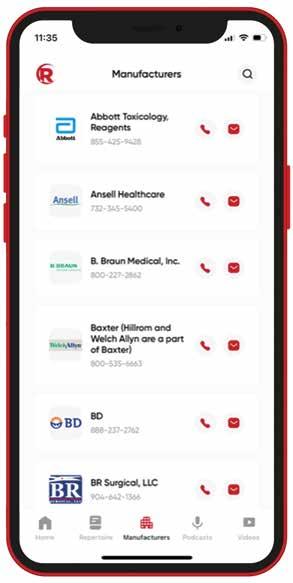
Save 2-4 hours/week of search time
Quick share buttons saves paper (go green)
Make your to-do list a to-done list
Everything you need in 1 place
Download

the app
GET CONNECTED
Emerging Leaders Program Recognizes New Generation Of Supply Chain Professionals
 There were some new faces at HIDA’s MedSupplyChain Conference in Cape Coral, Florida this February – 12 college students representing the inaugural class of Medical Supply Chain Emerging Leaders. While at the conference, these students attended panel discussions about healthcare distribution, engaged in networking opportunities, and met with industry leaders. They learned about opportunities and challenges in the medical supply chain, and brought a unique perspective to conversations at this important event.
HIDA’s Emerging Leaders come from diverse backgrounds. They include firstgeneration college students, students who have studied abroad, and those balancing their education with part-time employment. These students are currently studying at a variety of schools across the United States – Auburn, Wayne State, Arizona State, North Carolina A&T, and the University of South Carolina. All of them have work experience in healthcare, transportation, or logistics. Many have experience in all three.
The Emerging Leaders are passionate about healthcare distribution. Many of them are active in college clubs and organizations devoted to supply chain management and business. In their application essays, these students shared that their professional aspirations are rooted in personal experience. They want to help people, and believe that healthcare is the best place to do it. Some of them have seen the patient impact of medical supply chains firsthand when their loved ones were hospitalized.
One Emerging Leader recounted that, “My journey towards healthcare distribution is rooted in a profound connection with my grandmother, whose health struggles have ignited a passion within me to contribute meaningfully to the
healthcare system.” Another observed “What fuels my enthusiasm for the healthcare industry is not just the complexity of its operations but the impact it has on people’s lives.” We are grateful to have such thoughtful and enthusiastic students interested in our industry.
The Emerging Leaders program is part of HIDA’s ongoing commitment to workforce development and supplier diversity. We launched this program to give promising students a chance to learn about the medical distribution industry. Over the past two years, HIDA has developed strong connections with colleges and universities with programs in logistics and supply chain management. These connections gave us a pipeline from which to identify Emerging Leaders.
Supply chain management is a global industry that is evolving thanks to the latest advances in technology. Students with expertise in this field will have their pick of careers. We want them to choose careers in the medical supply chain. Healthcare distribution is a compelling field in which to work. It offers the opportunity to work with diverse teams to help the communities in which we live. With time, we hope that these Emerging Leaders will earn their degrees and assume roles in our industry.
 By Stephanie Reed, Director of Education, Health Industry Distributors Association
By Stephanie Reed, Director of Education, Health Industry Distributors Association
Repertoire www.repertoiremag.com 52 March 2024 HIDA
Go-to-Market Strategies
The digital health landscape provides opportunities for organizations to make their mark.
 Mobile health, health IT, wearable devices, telehealth and telemedicine, and personalized medicine are transforming patient care. One in three smartphone users monitor health and fitness through their phone and over half of Americans are comfortable with virtual consultations. Digital technology is changing the fragmented healthcare system to center around consumers.
The American Medical Association identifies three key trends rising to the top of the digital health landscape include:
Consumerization of healthcare: the retail healthcare model is being highlighted as the future of patient care.
Access for underserved communities: access to healthcare remains a significant challenge for many individuals in the U.S.
Application of big data: healthcare data is a highly sought after commodity, with organizations increasingly seeking to harness and interpret what they, and others, collect.
These trends are providing opportunities to bring digital solutions to the healthcare marketplace. To do that, organizations must create go-to-market (GTM) strategies to gain a comprehen-
sive understanding of the marketplace, the target market and a potential product’s place in it.
The most common challenges when launching GTM strategies for digital solutions, according to PricewaterhouseCoopers (PwC), are the lack of experience selling or positioning and measuring value. Successful GTM strategies include defining the benefits, creating value frameworks, identifying relevant stakeholders, developing value messages, determining the right channel mix and content type for each stakeholder, and then building a strategy.
Traditional stakeholders usually include patients and clinicians, and non-traditional stakeholders might include specialty healthcare providers and others. They demand a transformation of marketing and customer engagement led by customer needs. Identifying their digital acumen helps identify those needs.
For example, PwC highlights four physician personas that differ in the level of digital savviness:
Traditionalists: physicians who only use digital tools available when necessary.
Digital Explorers: physicians who start to realize the benefit of digital tools.
Digital Adopters: physicians who try to use digital tools as often as possible and are quick to get started.
Next Normal Champions: physicians who are among the first to use digital tools and encourage others to use them.
PwC says it’s important to define must-win moments and value messages for each. This can be a physician willing to support patients with treatment-related information despite having limited time with patients. Organizations can position digital solutions as valuable to physicians because they help patients access treatment-related content without the physician.
Measuring the value of digital solutions is challenging. Sales numbers can struggle to depict it. Organizations need to put value frameworks in place in order to highlight stakeholder value over sales numbers. Qualitative KPIs like outcomes, engagement and activity can measure the effectiveness of communication strategies and the perception of brand reputation.
How can your organization get creative with your marketing campaigns for 2024? At Share Moving Media we help best in class manufacturers build relationships with the industry’s decision-makers. Please contact us at sadams@sharemovingmedia.com to learn how we can help you gain market share through distribution.
Repertoire www.repertoiremag.com March 2024 53 MARKETING MINUTE
U.S. Cancer Statistics Released
Cancer rates are on the rise in younger adults.
 Cancer mortality has continued to decline nationally. There have been 4 million fewer deaths related to cancer in the U.S. since 1991, according to the American Cancer Society’s (ACS) Cancer Statistics 2024 report . Factors that may be impacting the decline in mortality include fewer people smoking, earlier detection for some cancers, and improved treatment, according to the ACS.
The progress, however, has been compromised by an increased incidence of 6 of the top 10 most common cancers. The projected number of new cancer diagnoses for 2024 has topped 2 million for the first time ever, according to the ACS report.
Lack of cancer prevention tactics has resulted in higher rates of common cancers including breast, prostate, endometrial, colorectal, and cervical cancers, especially amongst younger adults.
Cancer rates in younger adults
The sharp increase in cancer rates among younger Americans is concerning to physicians. Increased screening, awareness of non-invasive tests for colorectal cancer, and follow-up care is important, especially for individuals 45-49 years old. With colorectal cancer especially, according to the ACS, up to one-third of people diagnosed before age 50 have a family history or genetic predisposition for the disease. These individuals should begin screening for cancer before 45 years of age.
Colorectal cancer incidence has moved from being the fourth leading cause of death two decades

ago, to now being the leading cause of death for men and the second leading cause in women. Adults under 50 years of age have seen increased cancer mortality overall, with breast cancer leading among women under 50. There were more than 2,000 breast cancer deaths among women under 50 in 2021, according to the ACS.
Cancer patients are getting younger: the proportion of diagnoses in people who are 50-64 years old increased from 25% in 1995 to 30% in 20192020. According to the ACS, stressors on people younger than 65, such as lack of health
insurance, managing families, and working full time may be a factor in increased cancer rates within younger age groups.
Cancer rate disparities
Mortality rates for certain cancers show wide static cancer disparities. According to the ACS report, compared to White people, mortality rates are two times higher for prostate, stomach, and uterine corpus cancers in Black people, and for liver, stomach, and kidney cancers in Native Americans.
Steeper increases in women of color especially are widening racial disparities, with the death rate now two times higher in Black women (9.1 per 100,000) than in White women (4.6 per 100,000), according to the ACS.
The ACS 2024 report exemplifies a need for policy interventions that help reduce cancer disparities. According to the ACS, lawmakers should be urged to ensure that more people have health insurance coverage, improved access to care, greater affordability of healthcare services, increased cancer research funding, and improved screening programs.
Repertoire www.repertoiremag.com 54 March 2024 Health News
By the Numbers: Colorectal Cancer
38.4 %
The pandemic greatly impacted cancer screening, as many people delayed or stopped testing alto gether. According to the National Institutes of Health (NIH), from March 2019 to March 2020, there was a 38.4% decrease in colorectal cancer screening. March is Colorectal Cancer Awareness Month, recognizing the importance of getting colorectal cancer screening back on track and increasing early disease diagnosis.

18,000
Colorectal cancer rates are increasing nationally, especially among younger adults, according to the National Institutes of Health and the American Cancer Society. Nearly 18,000 people under 50 were estimated to have been diagnosed with colorectal cancer in the U.S. in 2020. Factors that impact the risk of developing colorectal cancer include obesity, inactivity, and smoking.
4th
Colorectal cancer is the fourth most common cancer among men and women, and the fourth leading cause of cancer-related death in the U.S., according to the Centers for Disease Control (CDC). The rate of new cases of colorectal cancer nationally is 36.6 per 100,000 men and women, per year, according to the National Cancer Institute.
65%
Individuals with a family history of colon cancer or inflammatory bowel disease, and those who have had cancer before should test for colorectal cancer annually. The risk for developing colon cancer is much higher for at risk groups, according to the CDC.
According to the National Cancer Institute, there is an estimated 5-year survival rate of 65 percent for individuals diagnosed with colorectal cancer. If you fall into a category with higher risk, test early and often to ensure you are healthy and cancer-free.
4.1%
Colorectal cancer, or colon cancer for short, is a disease in which cells in the rectum grow out of control. The colon is the large intestine, and the rectum is the passageway that connects the colon to the anus. Abnormal growths called polyps can form in the colon or rectum, and over time, some polyps may turn cancerous. Approximately 4.1 percent of men and women will be diagnosed with colorectal cancer at some point during their lifetime, according to 2017-2019 data from the National Cancer Institute. Screening tests help to find colorectal cancer in its early stages, when treatment works best.
45
A colonoscopy is the primary test for identifying colorectal cancer, and it is recommended for all individuals aged 45 and older, according to The American Cancer Society. The test looks for signs of cancer in an individual’s stool to determine abnormalities. Signs and symptoms of colon cancer, according to Mayo Clinic, include a change in bowel habits, stomach discomfort, bleeding, weakness, and weight loss.
153,020
In 2023, colorectal cancer had an estimated 153,020 new cases throughout the United States, according to the National Cancer Institute. In 2020, the National Cancer Institute estimated that nearly 1,388,422 people were currently living with colorectal cancer in the United States.
Repertoire www.repertoiremag.com March 2024 55 Healthcare Facts and Figures
Industry News
Rob Albert appointed Chief Executive Officer of B. Braun of America Inc.
The Board of Directors of B. Braun of America Inc. (“B. Braun of America”) announced that they have appointed Rob Albert as Chief Executive Officer of B. Braun of America, succeeding Jean-Claude Dubacher who is taking on global management responsibilities, while remaining Chairman of the Board of B. Braun of America. Albert’s appointment will be effective April 1, 2024.
Albert joined the company in 1984 as a manufacturing supervisor in operations. In his nearly 40 years with the organization, he has held roles in Operations, Sales and Marketing. He has served as Senior Vice President & Chief Marketing Officer of B. Braun of America’s subsidiary, B. Braun Medical Inc., since 2012.
Throughout his career, Albert has been active in both industry and community leadership roles. He is currently on the Board of Directors of the Association for Accessible Medicines and the Chairman of the Foundation Board of Northampton Community College. He holds a Bachelor of Science degree in Business Management and Marketing from Clarion University.
Midmark Synthesis
Wall-Hung Cabinetry wins international design award Midmark Corp. announced that its Synthesis Wall-Hung Cabinetry earned the internationally renowned GOOD DESIGN Award from the Chicago Athenaeum Museum of Architecture and Design.
Selected as a winner in the furniture category for innovative and cutting-edge design, the Midmark Synthesis Cabinetry Collection is designed specifically for the clinical environment to help enhance workflow, ergonomics, technology integration and infection prevention at the point of care. Synthesis Wall-Hung Cabinetry improves ergonomic reach and visibility while helping enhance storage efficiency and infection prevention.
Synthesis Wall-Hung Cabinetry features base and tall cabinets that better position the mostused areas of storage for easier reach by physicians and staff. For instance, the lower upper height and thinner depth of the cabinets improve access to storage with less reach and lean required. Additionally, the use of gravity-fed, angled flow-shelving improves visibility and access to supplies, even for items stored toward the back of the cabinet.
BD, Techcyte collaborate, offering digital cervical cytology system
BD and Techcyte, a world leader in artificial intelligence (AI)-based digital diagnostics, announced a strategic collaboration agreement to offer an AI-based algorithm that guides cytologists and pathologists to efficiently and effectively identify evidence of cervical cancer and precancer using whole-slide imaging.
The agreement enables BD to deliver a complete solution that aims to reduce the potential for human error and enable greater throughput, so that labs can achieve their results with greater standardization, reproducibility, and efficiency from a Pap test, also known as a Pap smear.
Traditionally, Pap tests have been conducted by taking a sample from a patient and placing it on a glass slide that is visually evaluated by a cytotechnologist or pathologist using a microscope.
With the digital cervical cytology system, the samples can be scanned, converted to a digital slide image, and then reviewed on a computer monitor in a lab or from a remote location. In addition, the digital cervical cytology system uses an AI-based algorithm to prioritize and present clinically relevant cells for visual evaluation.
Repertoire www.repertoiremag.com 56 March 2024 News


Improving Patient Health Better BP®





Heart disease is the leading cause of death for Americans today and hypertension is a contributing and modifi able risk factor for heart disease and stroke. 1 Proper patient positioning alone can lower resting blood pressure (BP) measurements by 7 mmHg systolic and 4.5 mmHg diastolic. 2 That’s why, Midmark designed the fi rst and only fully integrated point of care ecosystem that has been clinically validated to achieve improved accuracy for a resting BP.




01 Low-height exam chair helps patients keep their back supported and feet fl at on the fl oor Articulating arm rail supports the patient’s arm and cuff at heart height
02 Automated vital signs promote consistency and data accuracy
03 EMR connectivity improves workfl ow effi ciency and reduces errors


Learn more about 3 key considerations (and products) at: midmark.com/3keytoBP





Scan to explore the latest study reporting the cumulative effect of poor positioning that occurs when BP is taken with the patient sitting on a typical clinical exam room table.



















1 https://www.cdc.gov/nchs/fastats/leading-causes-of-death.htm
2 https://www.thelancet.com/journals/eclinm/article/PIIS2589-5370(23)00396-6/fulltext
© 2024 Midmark Corporation, Versailles, Ohio USA
1
2 3









WE’RE HERE FOR YOU. WELCH ALLYN AND BAXTER ARE NOW ONE TEAM Baxter, Hillrom, and Welch Allyn are trademarks of Baxter International Inc. US-FLC157-240005 (v1.0) 01/2024 Our broad portfolio of Welch Allyn intelligent diagnostic tools and technology to support your physical exam, vision screening, hypertension management and cardiopulmonary testing practices your customers trust every day are available within 2 weeks. Let’s innovate the exam room together. Scan the code to view our current promotional rebate through March 31st.






























 Nate Spates Jr.
Nate Spates Jr.










































































 By Stephanie Reed, Director of Education, Health Industry Distributors Association
By Stephanie Reed, Director of Education, Health Industry Distributors Association












































